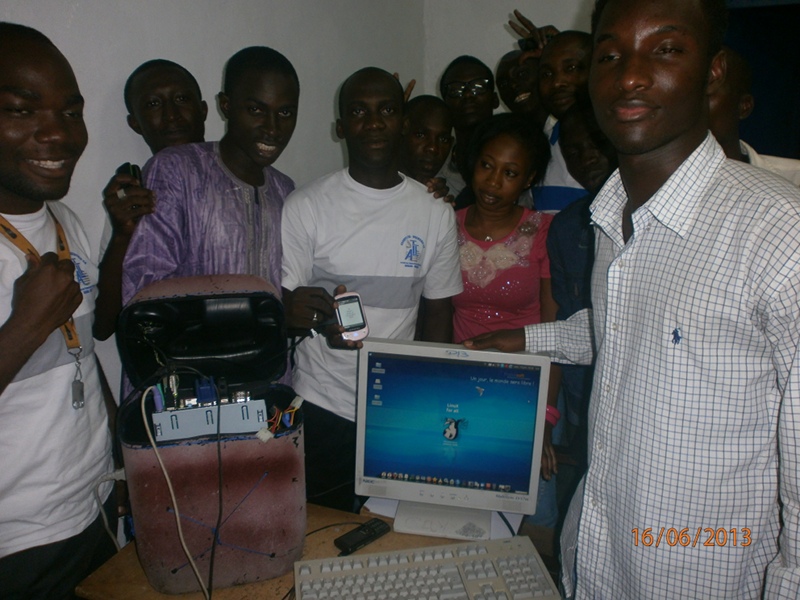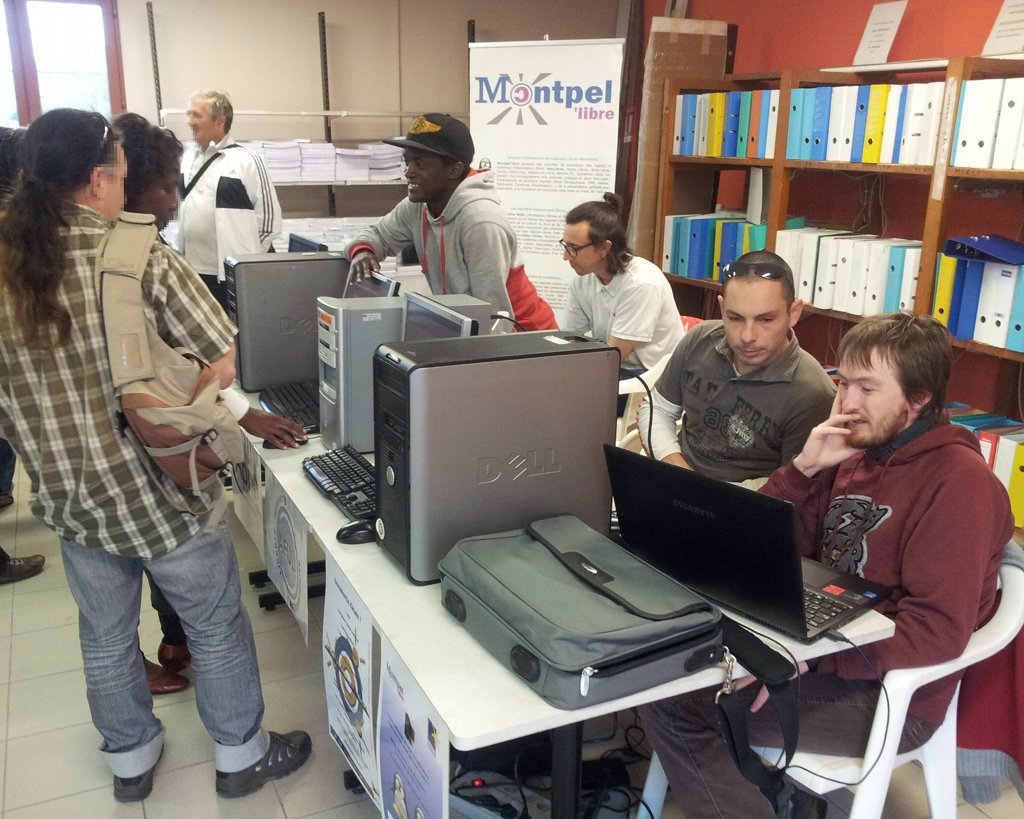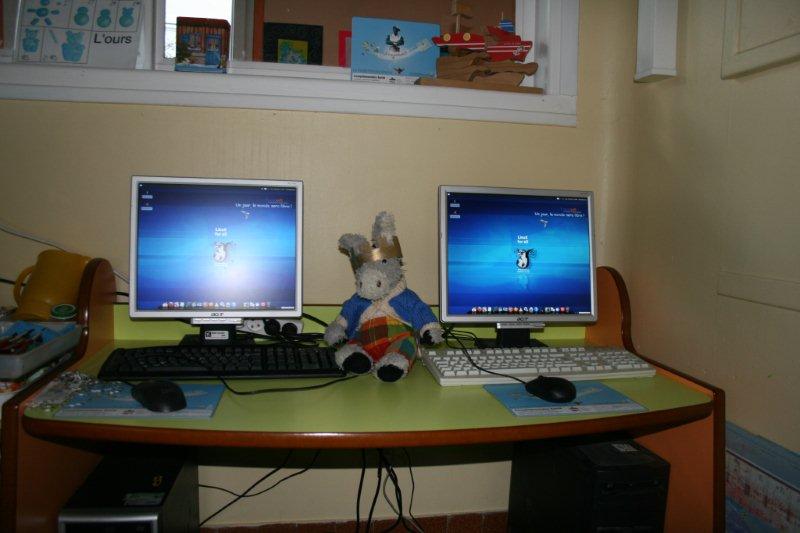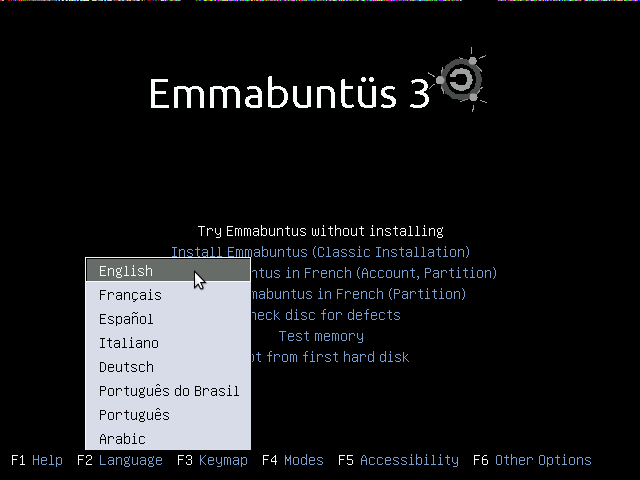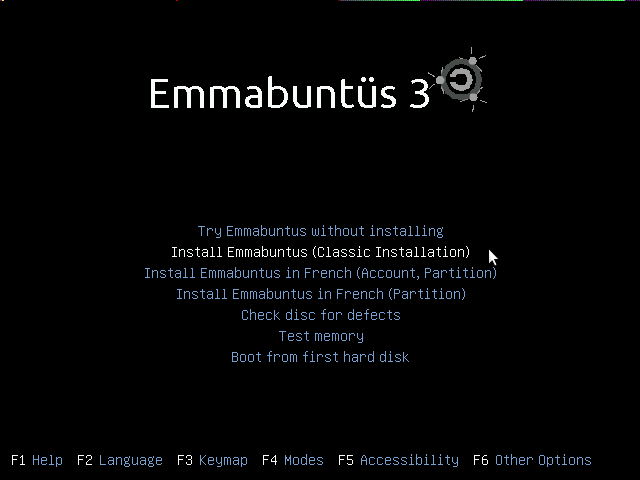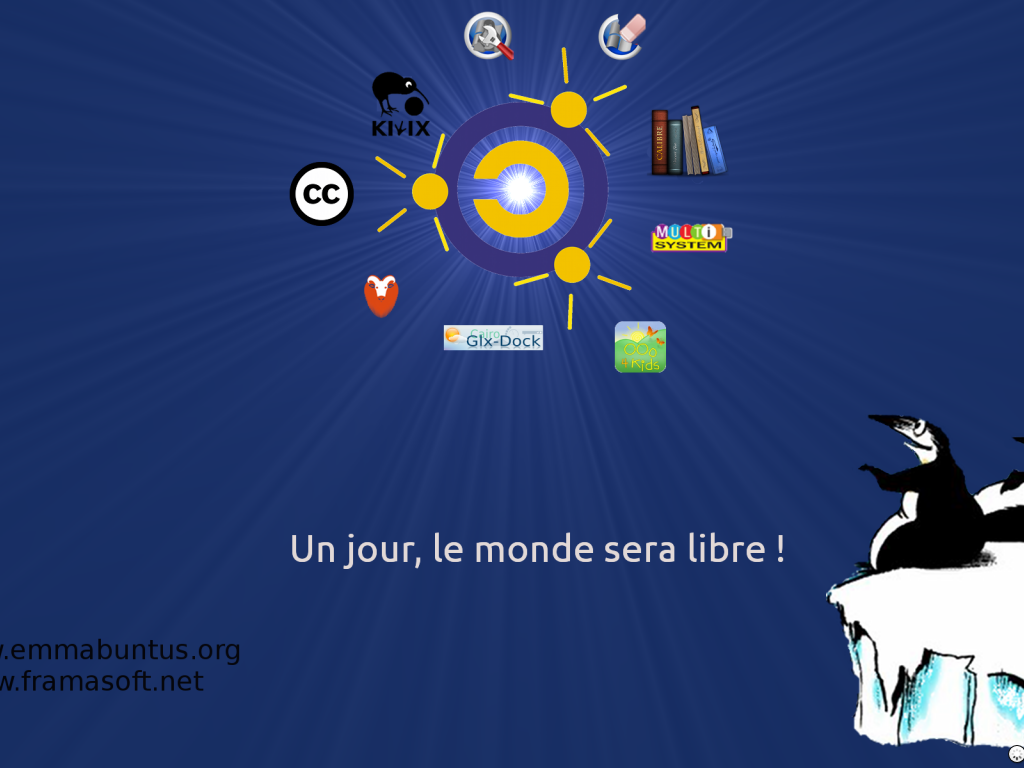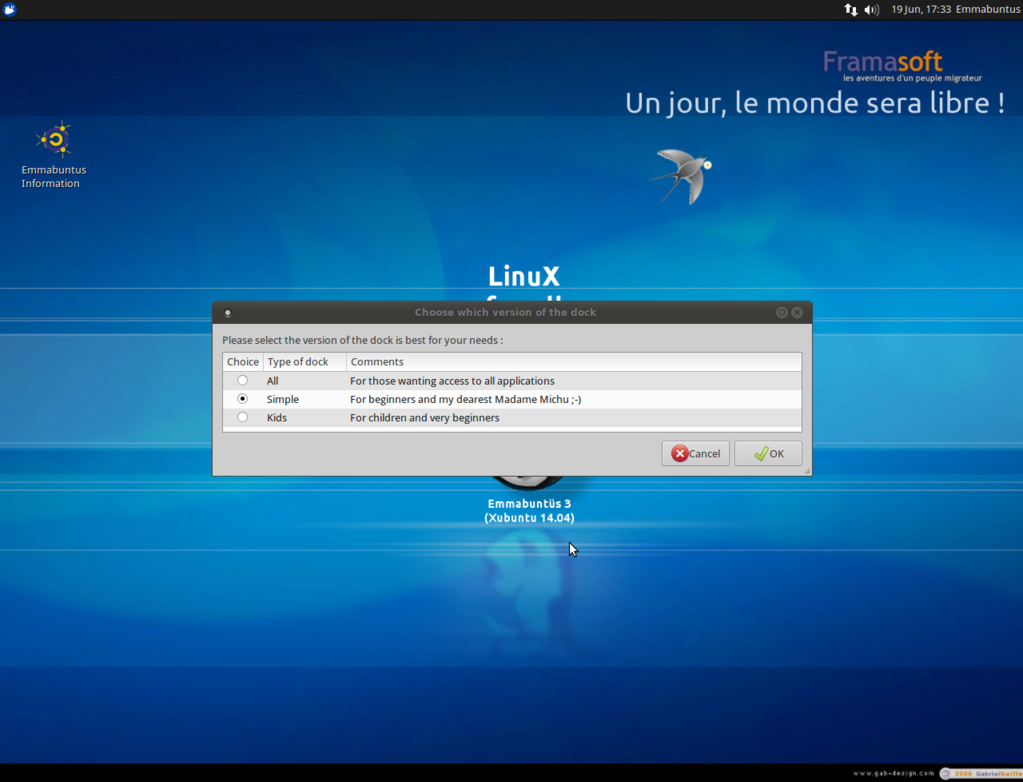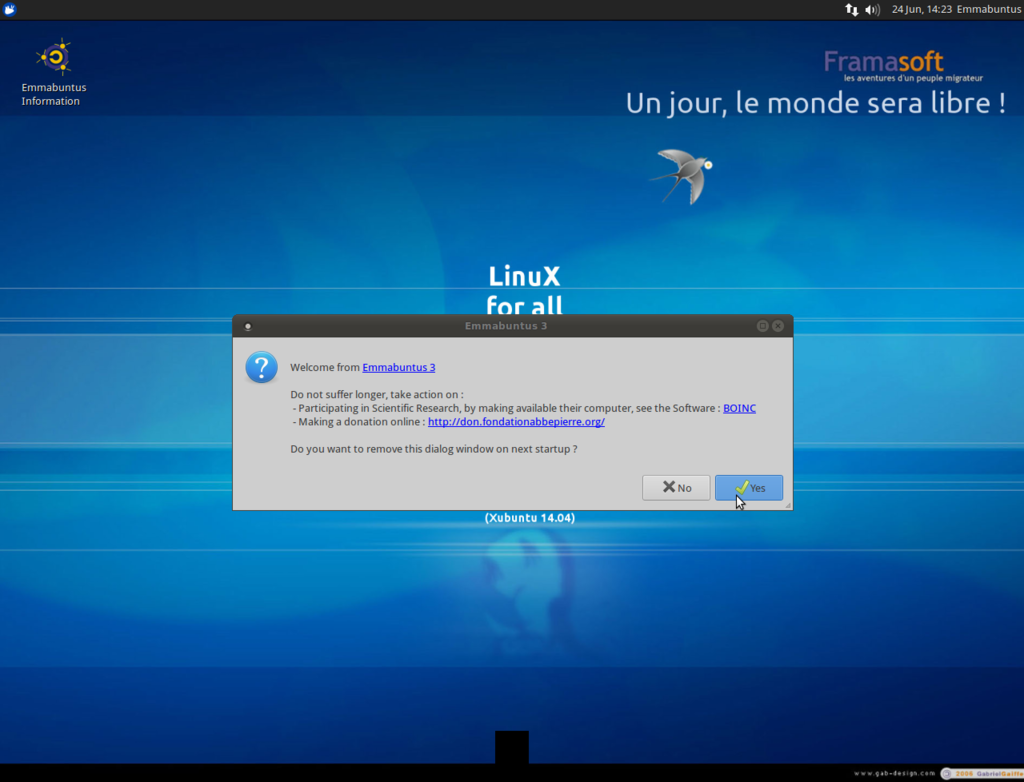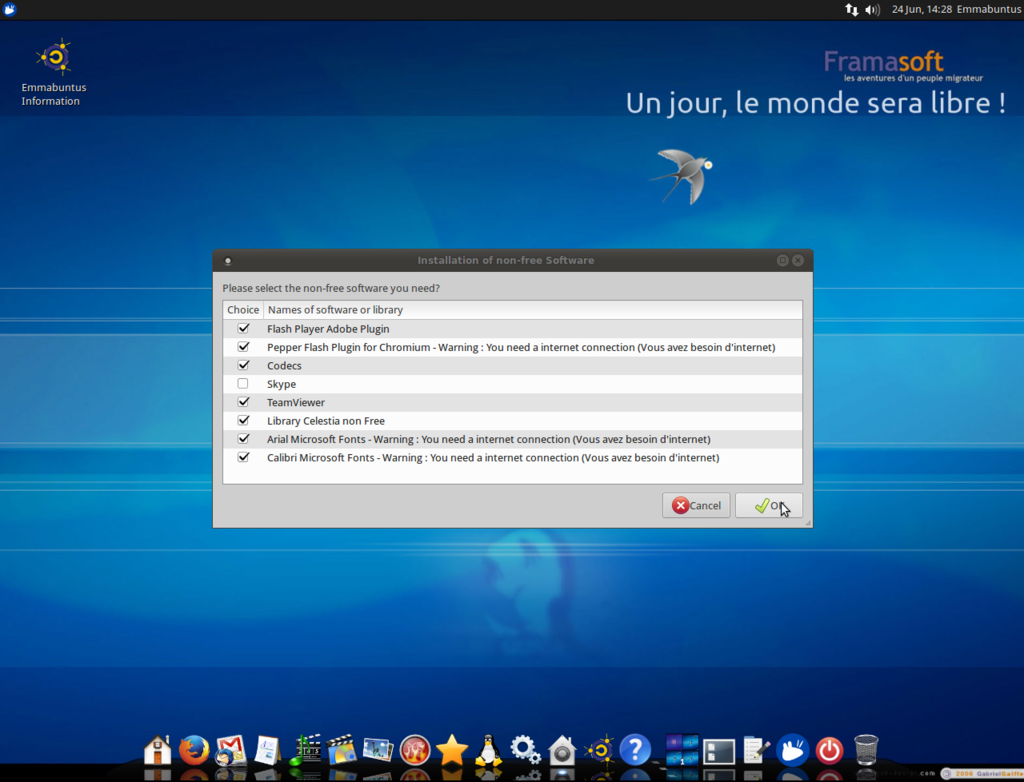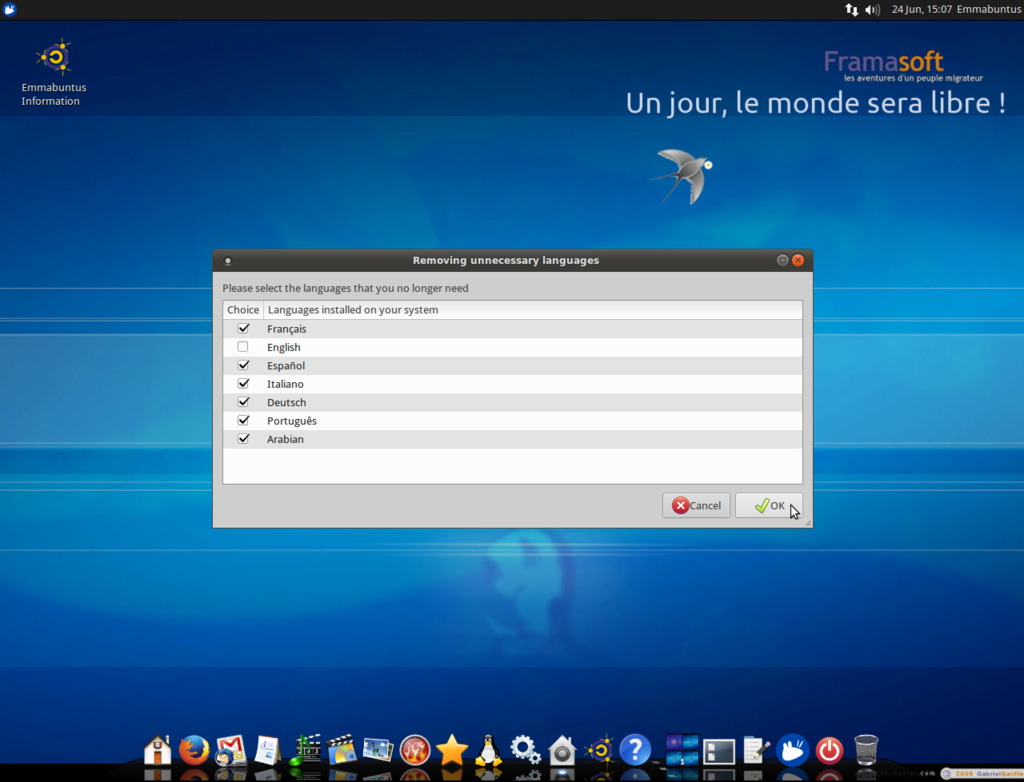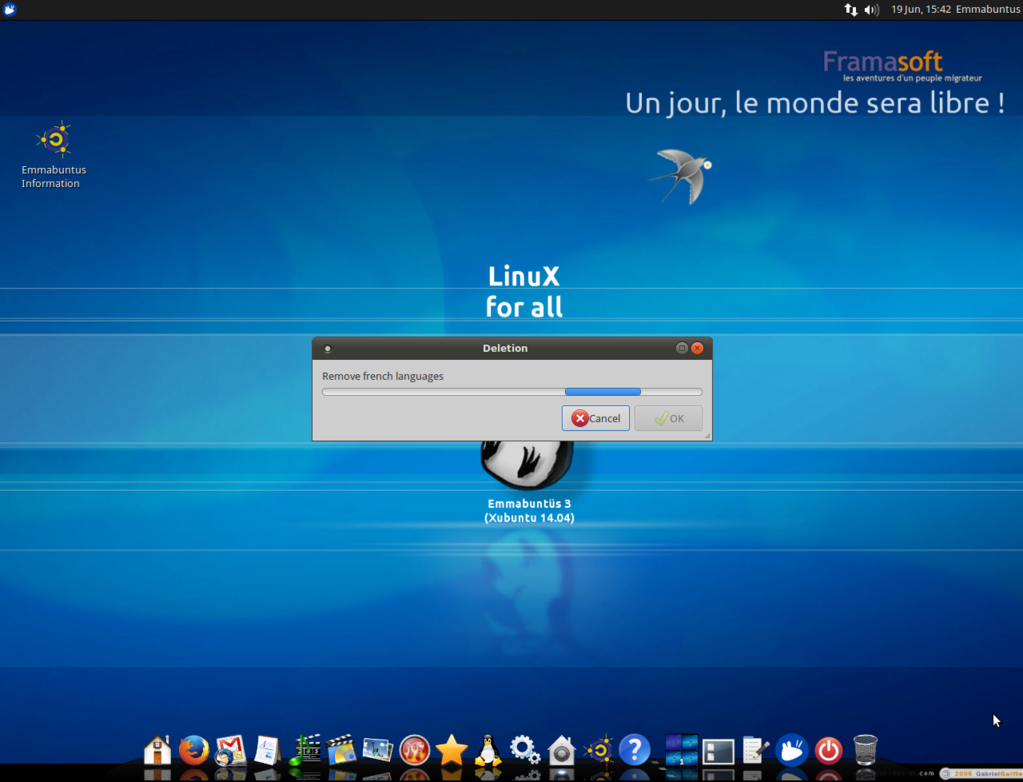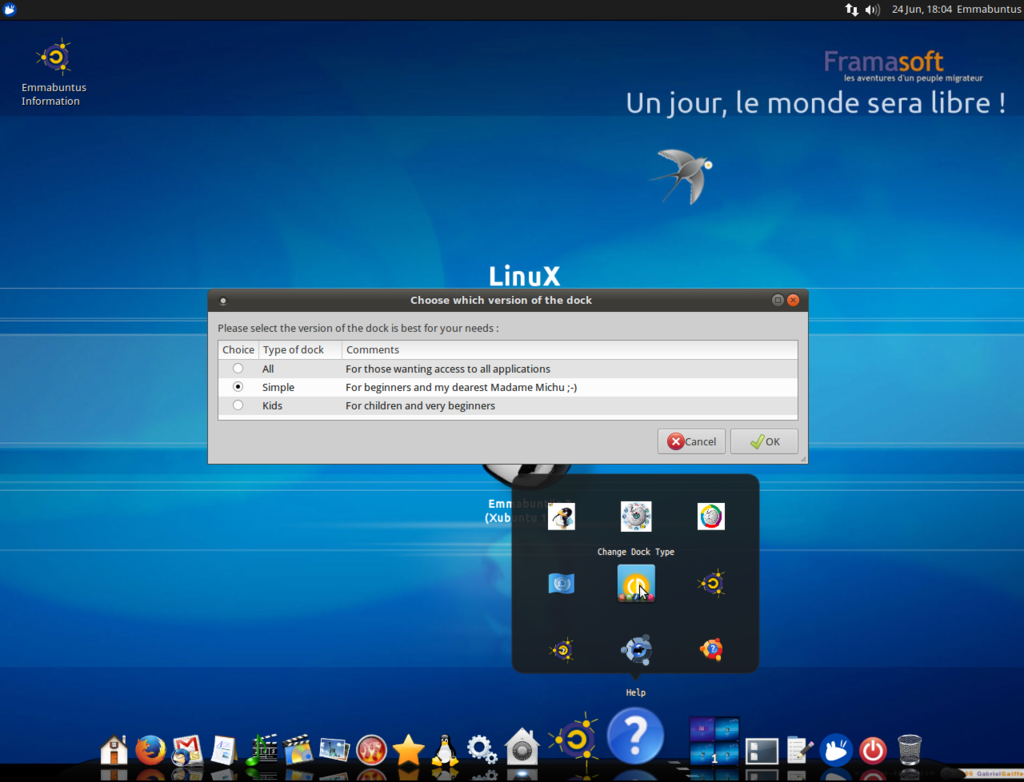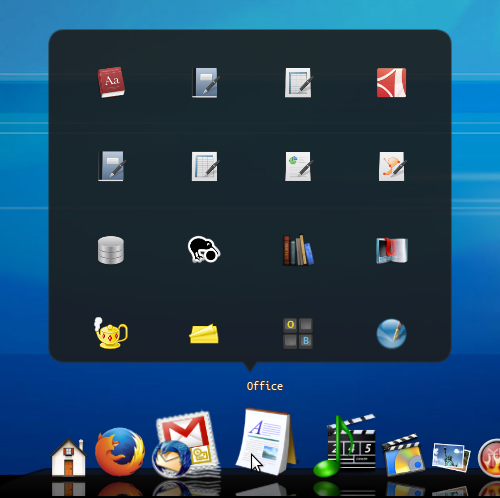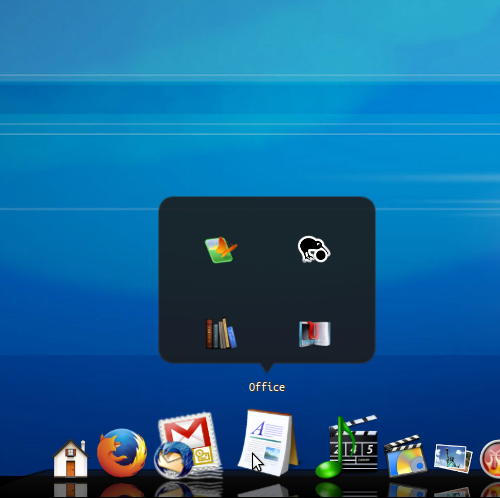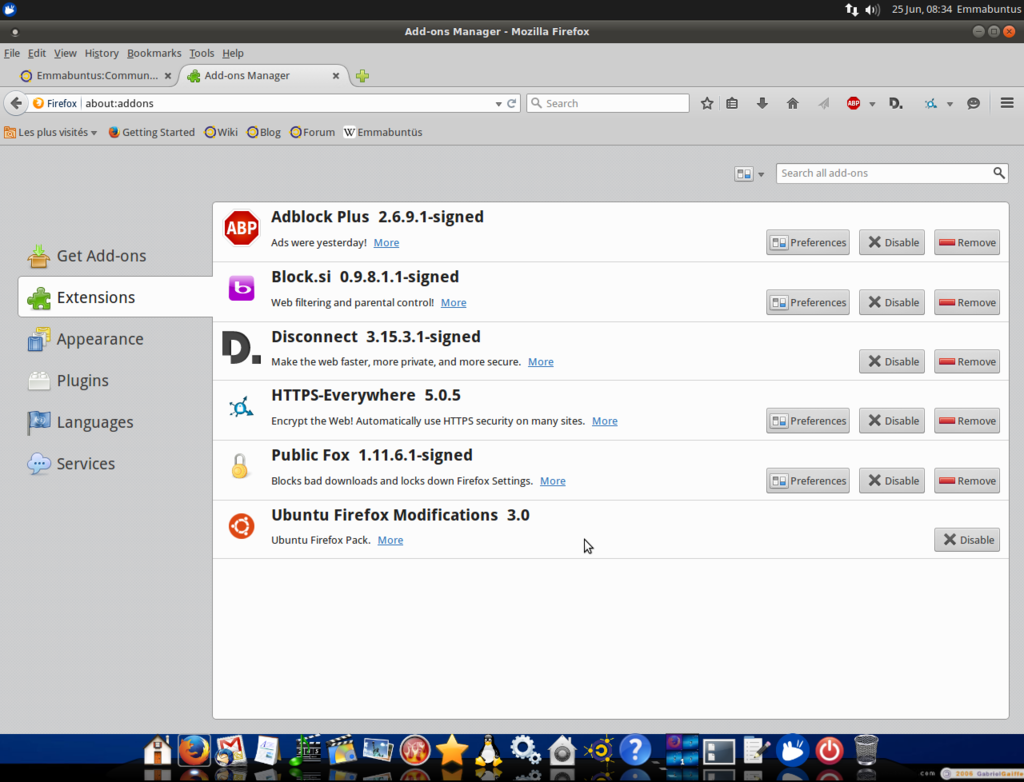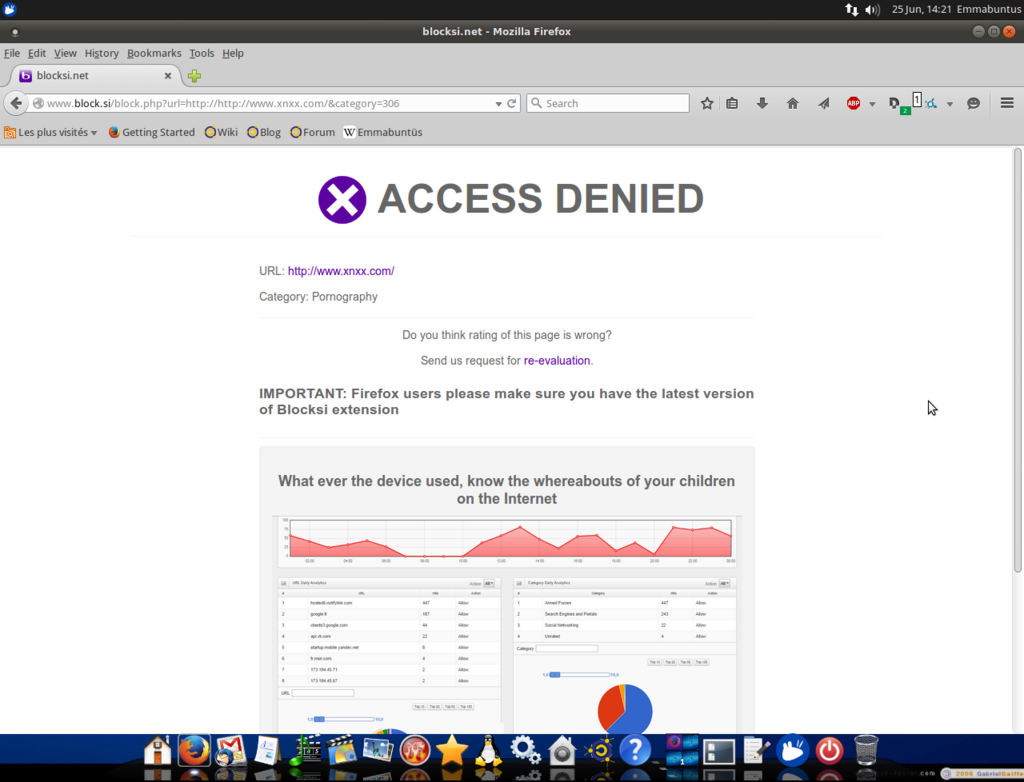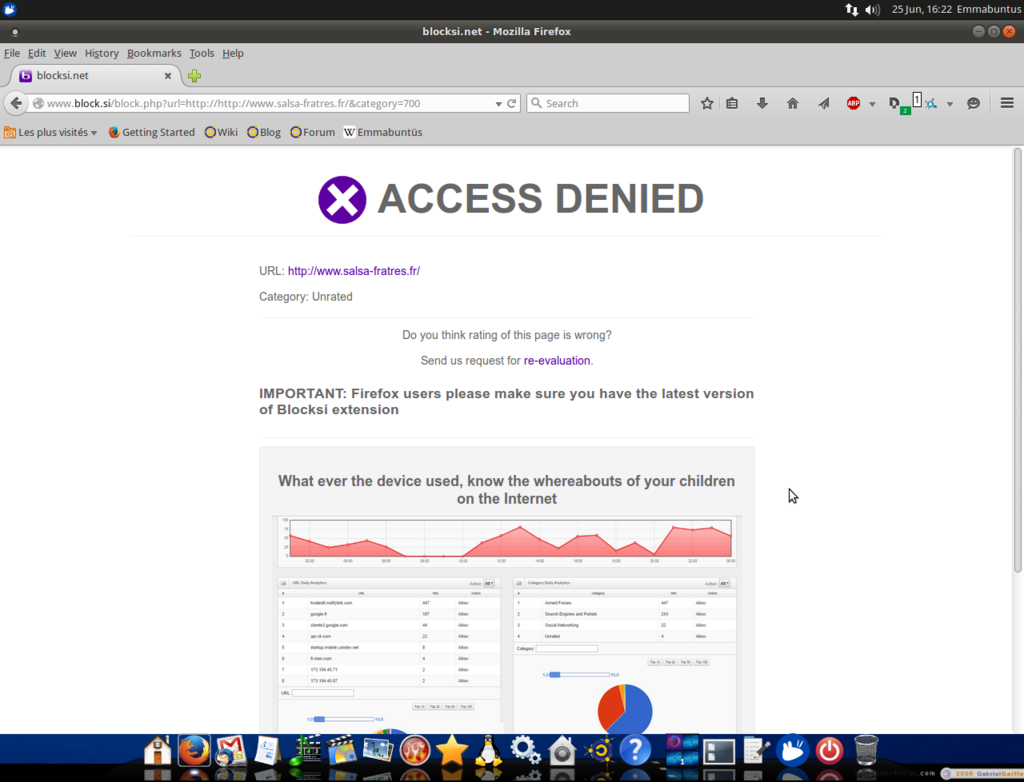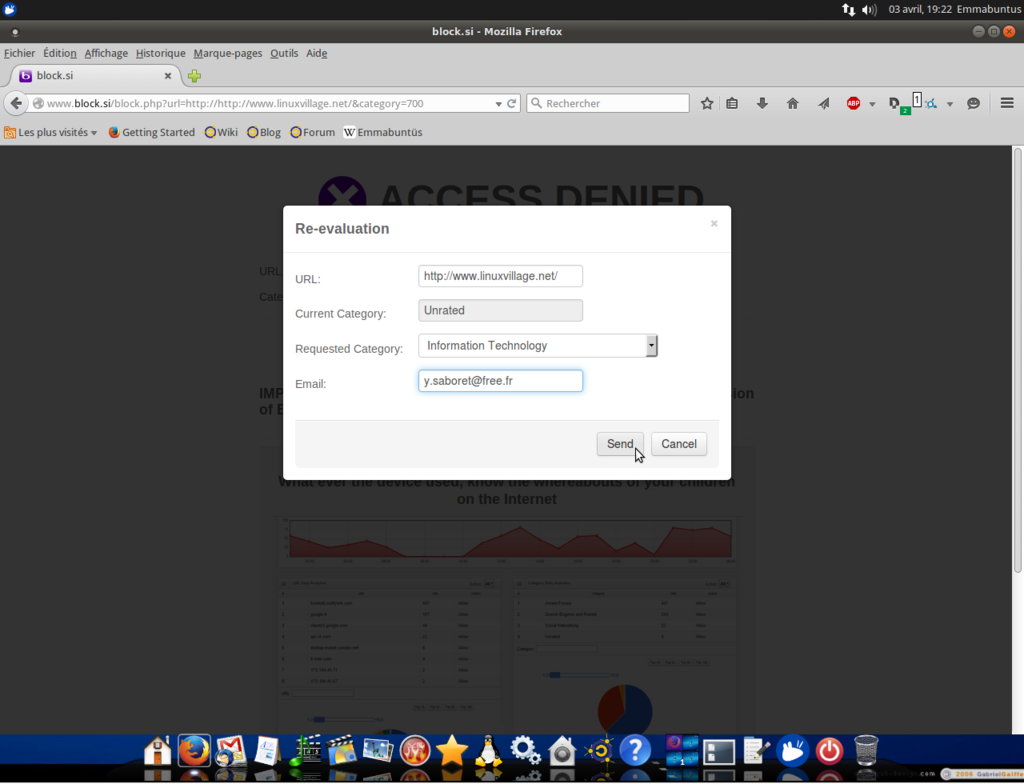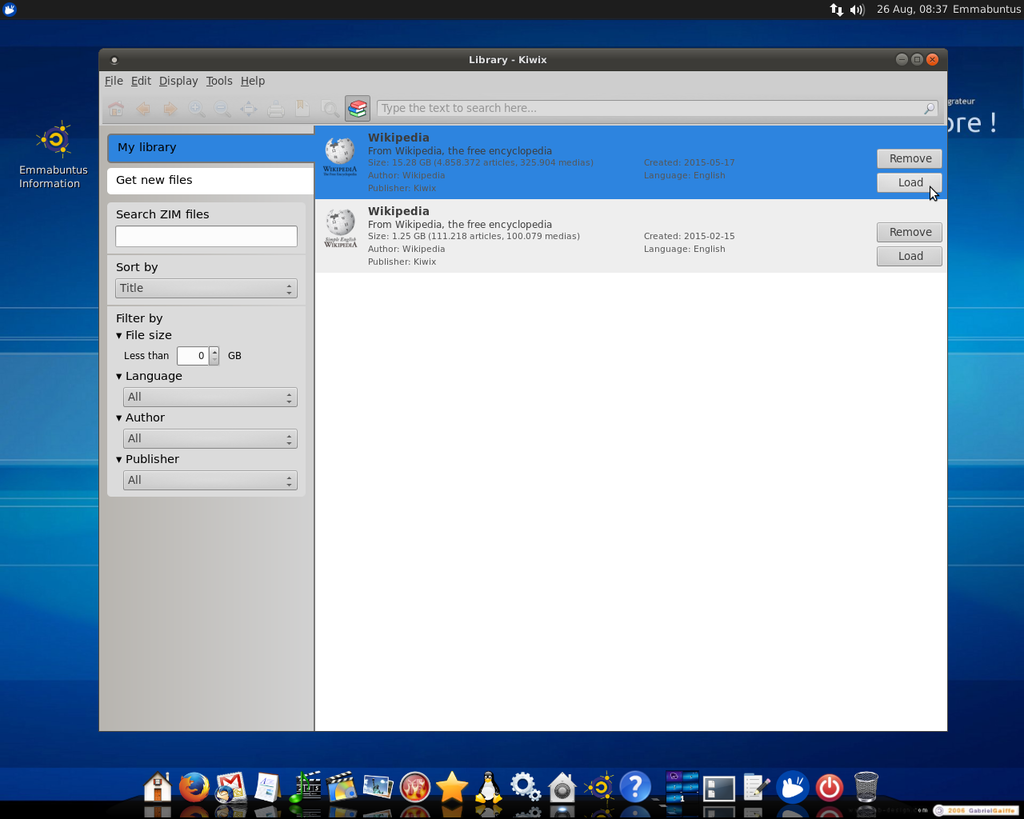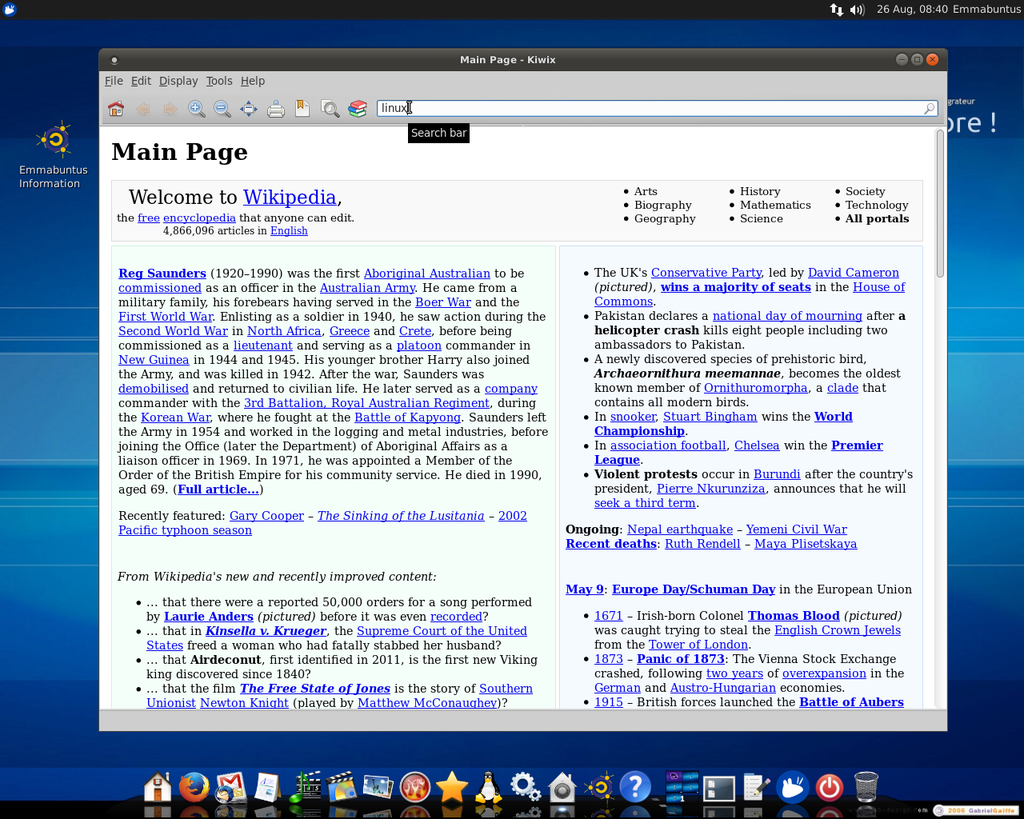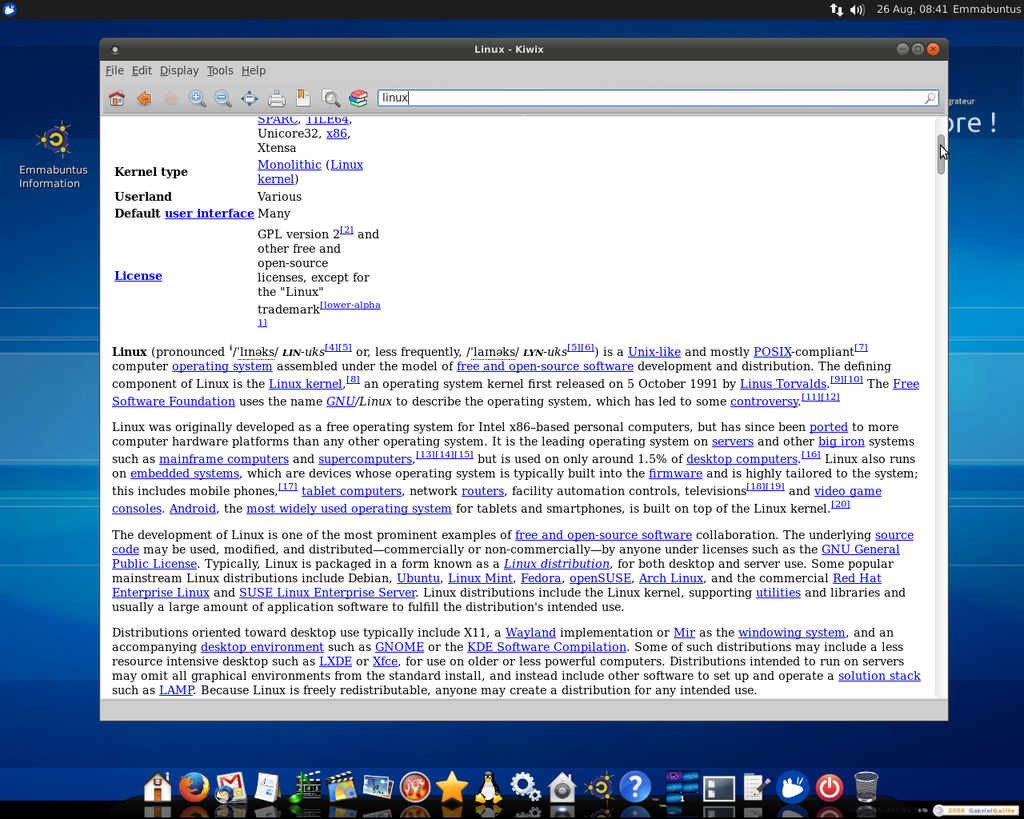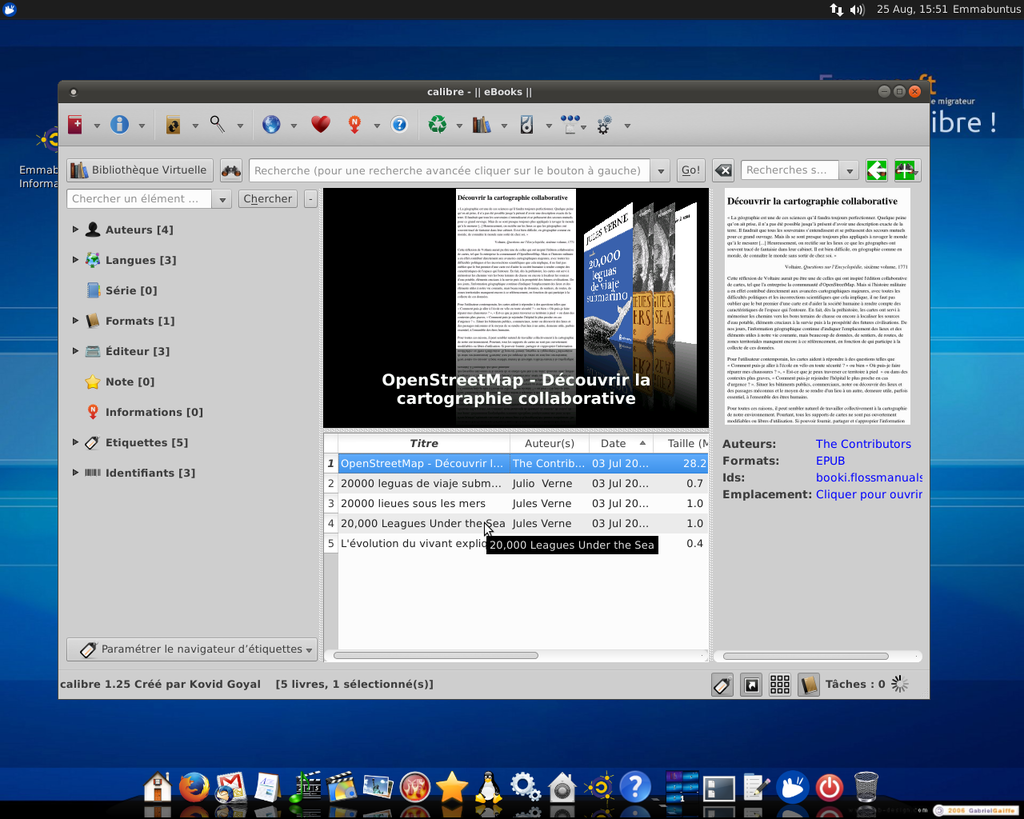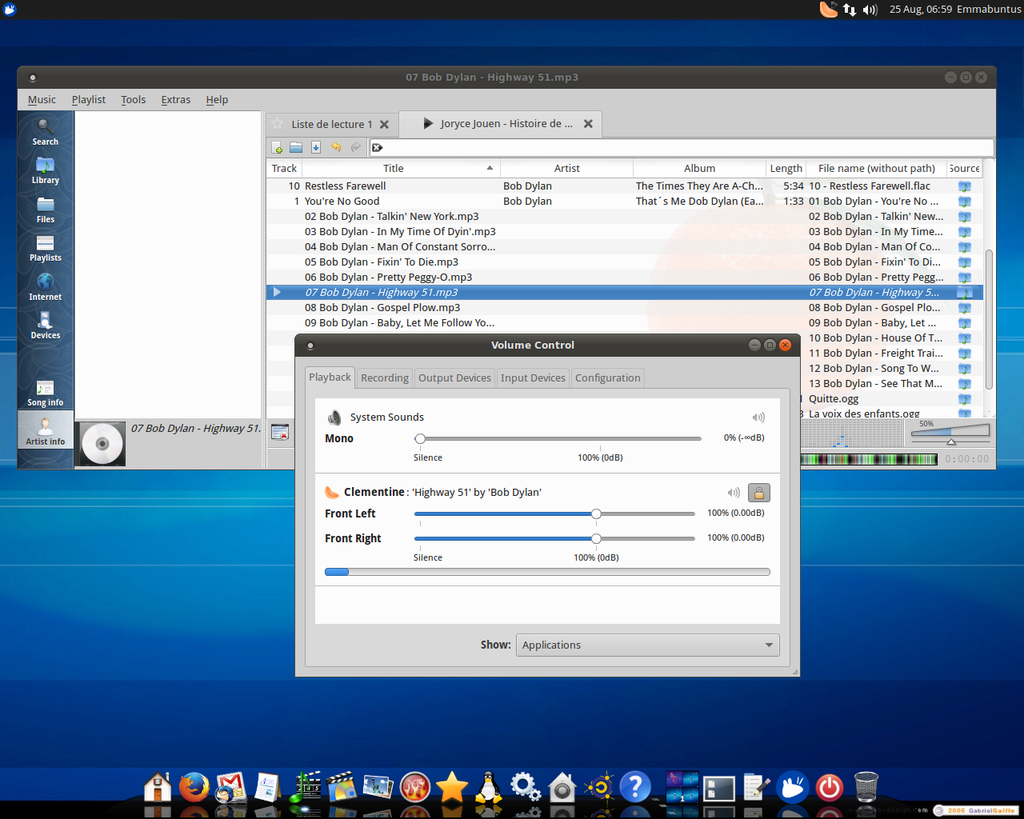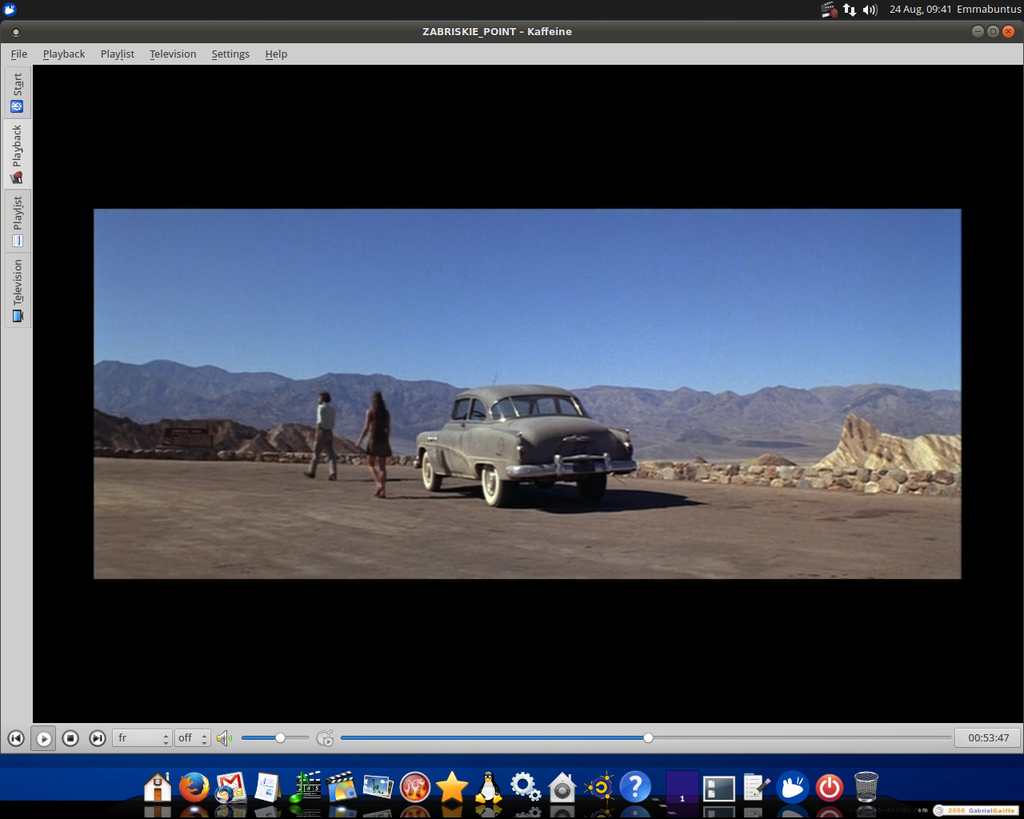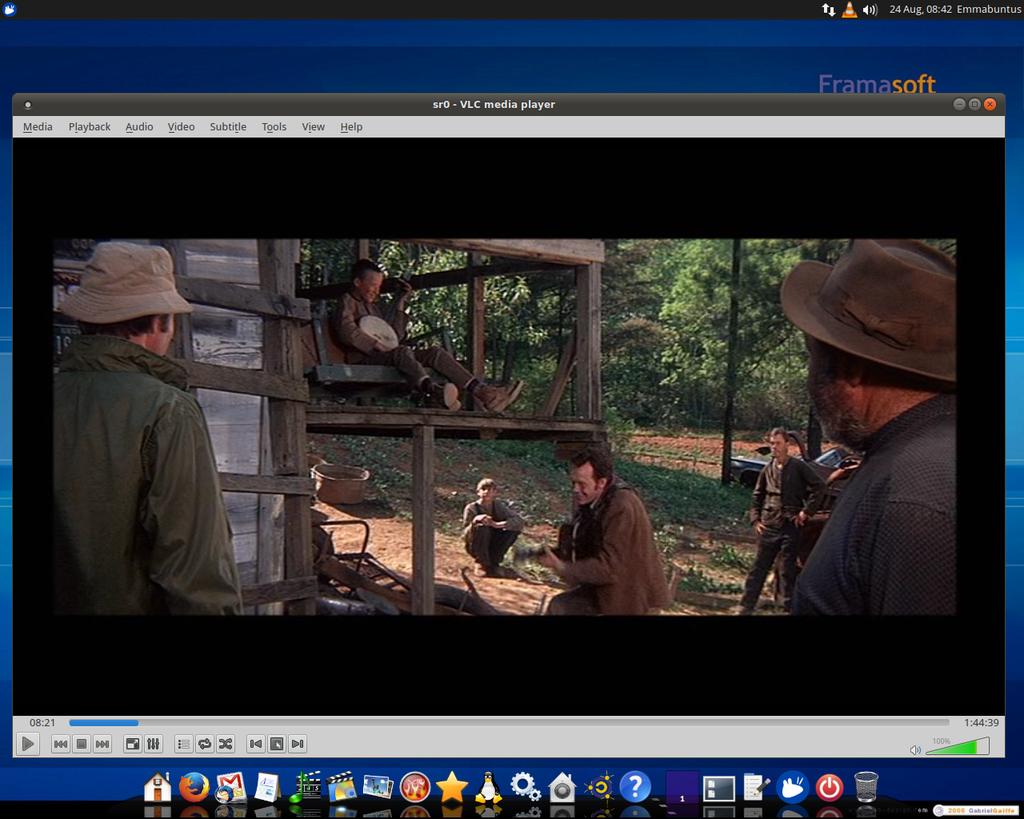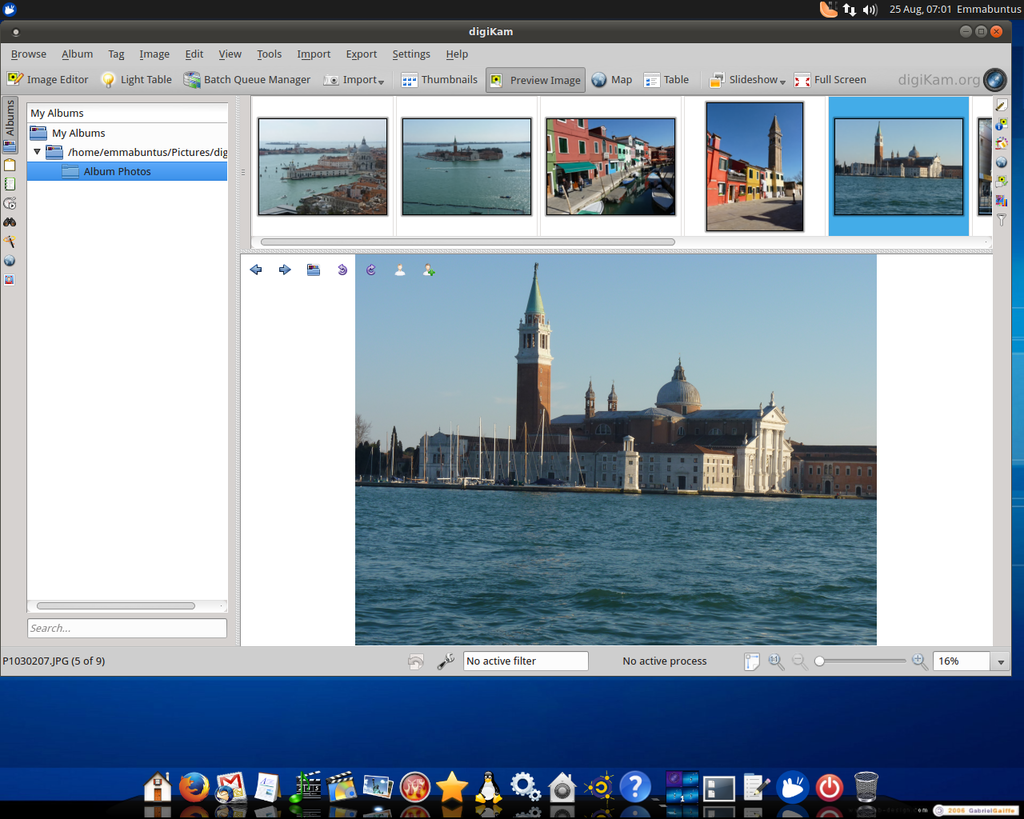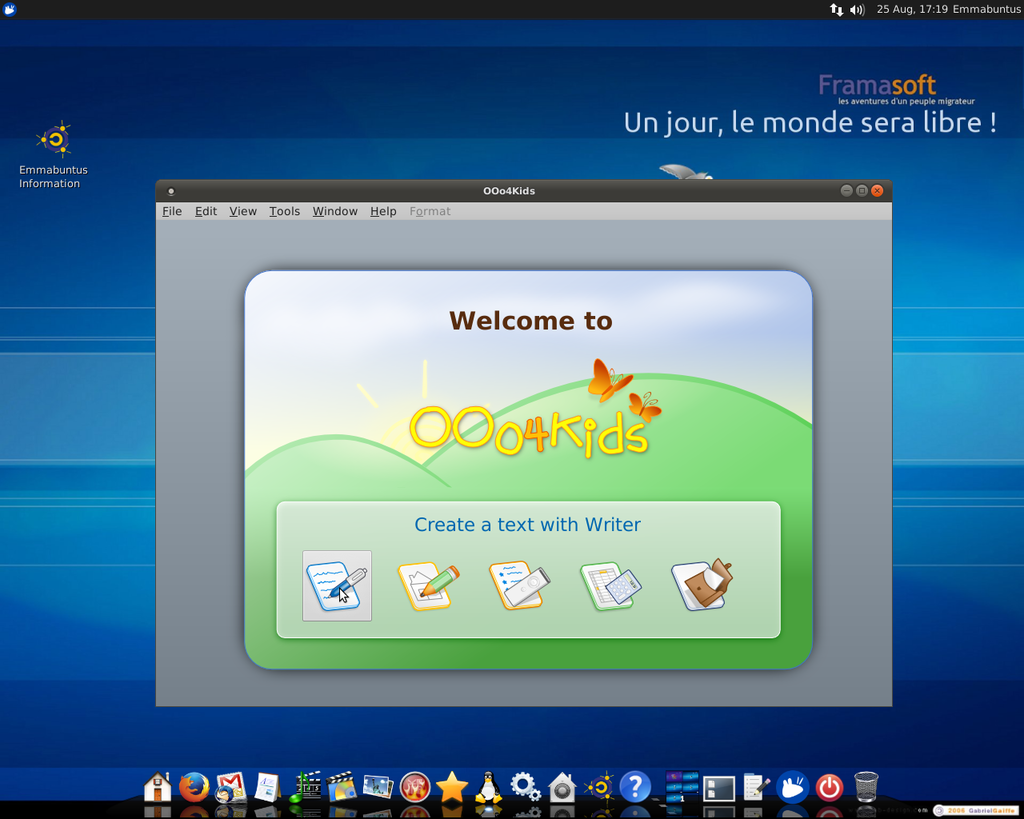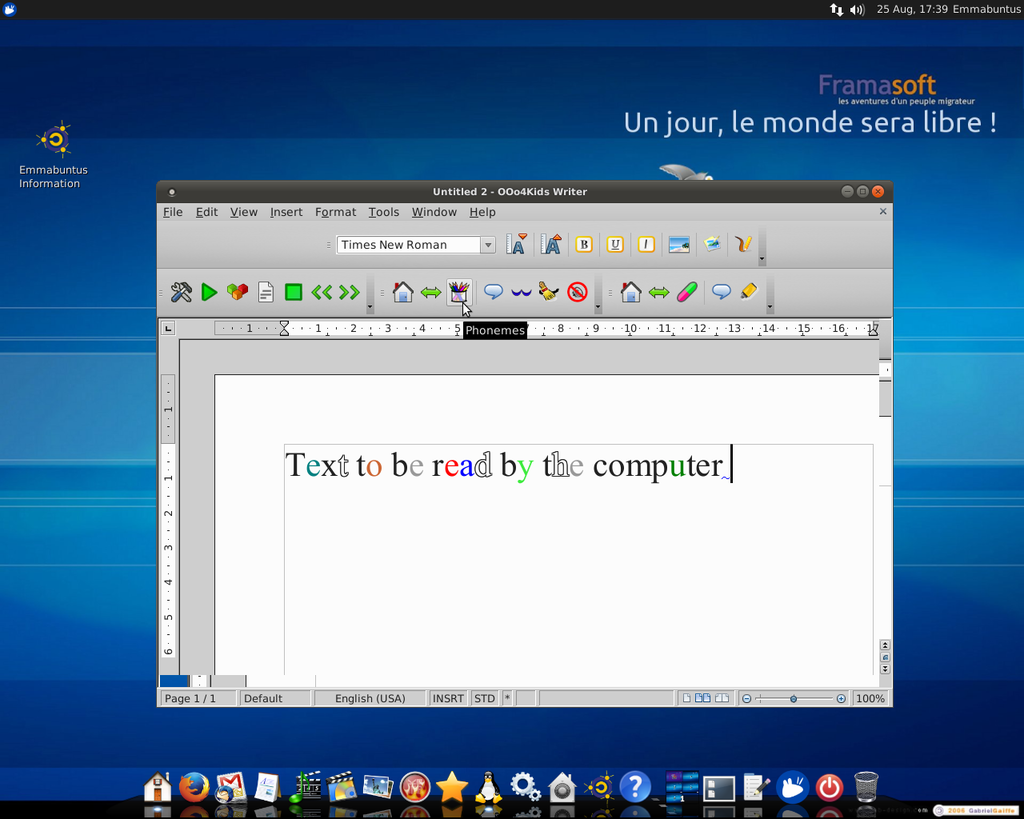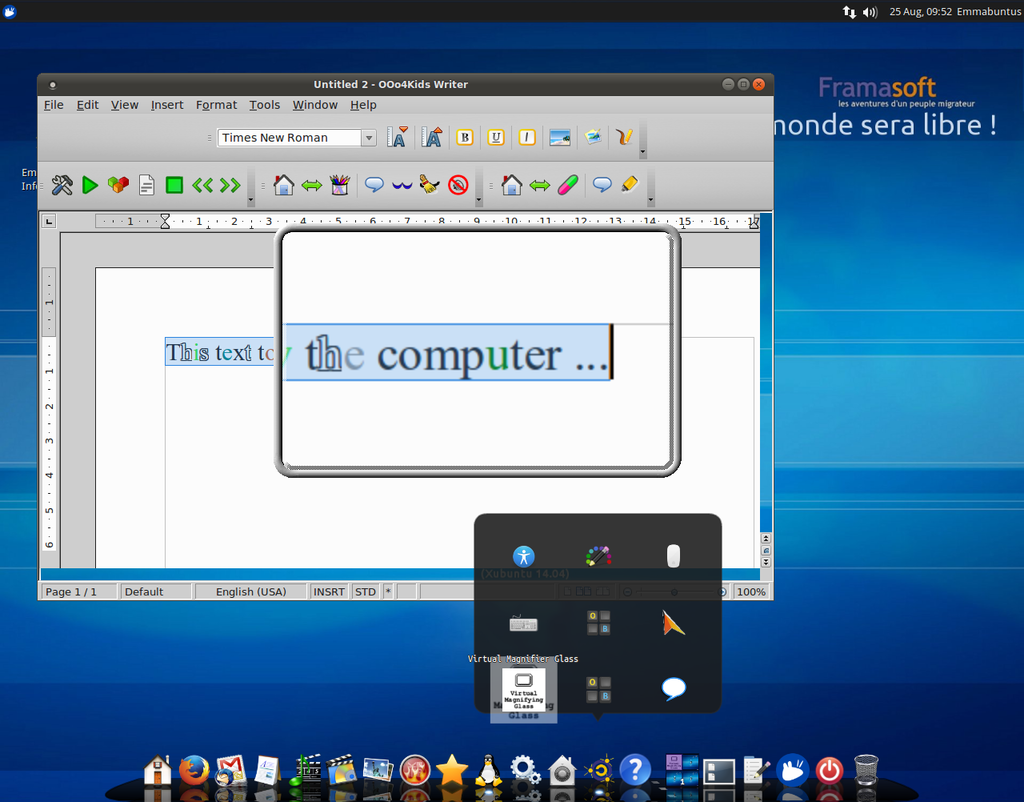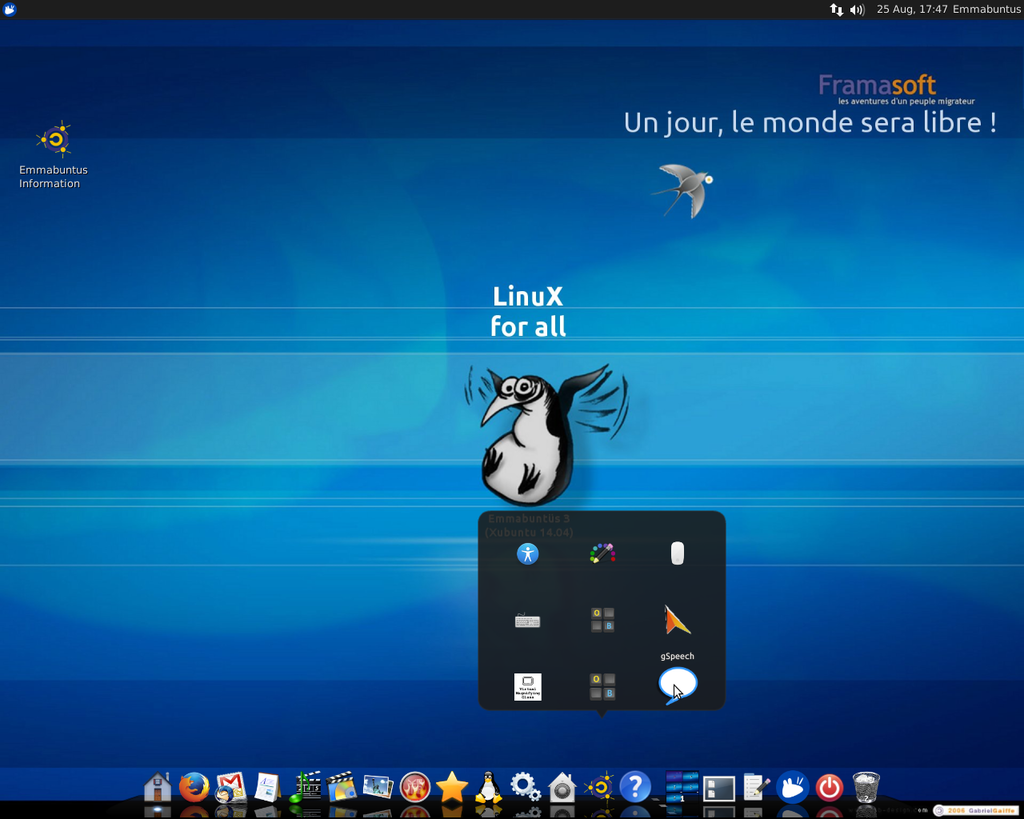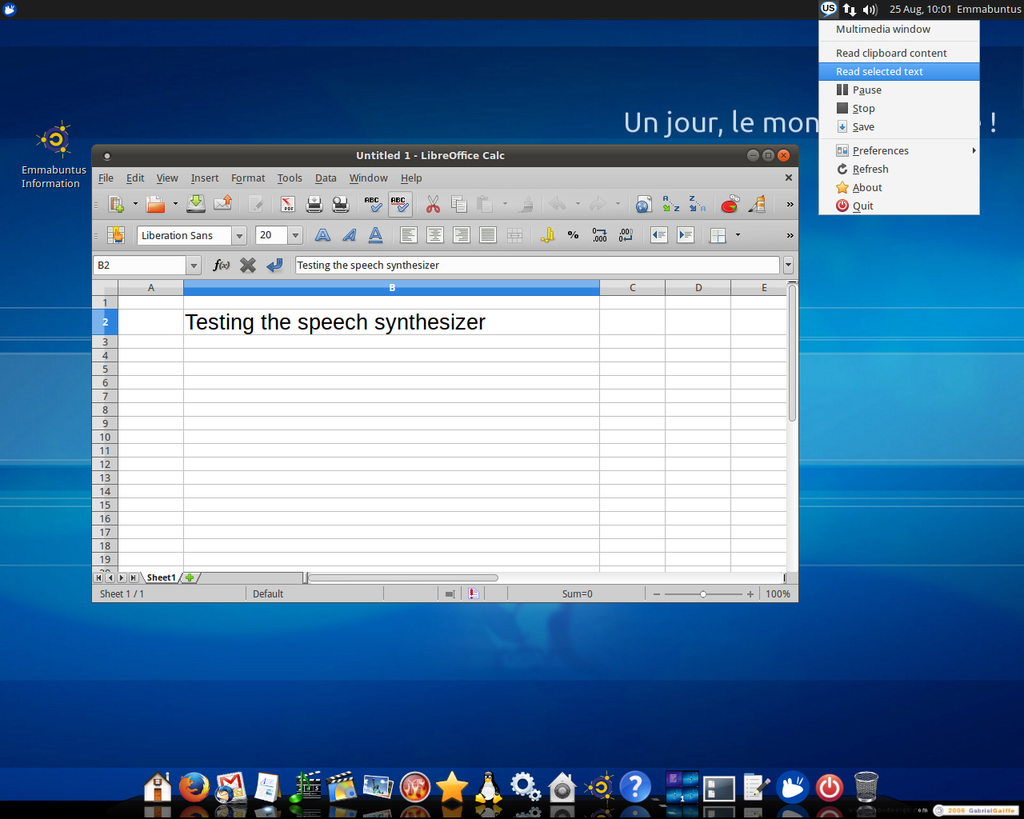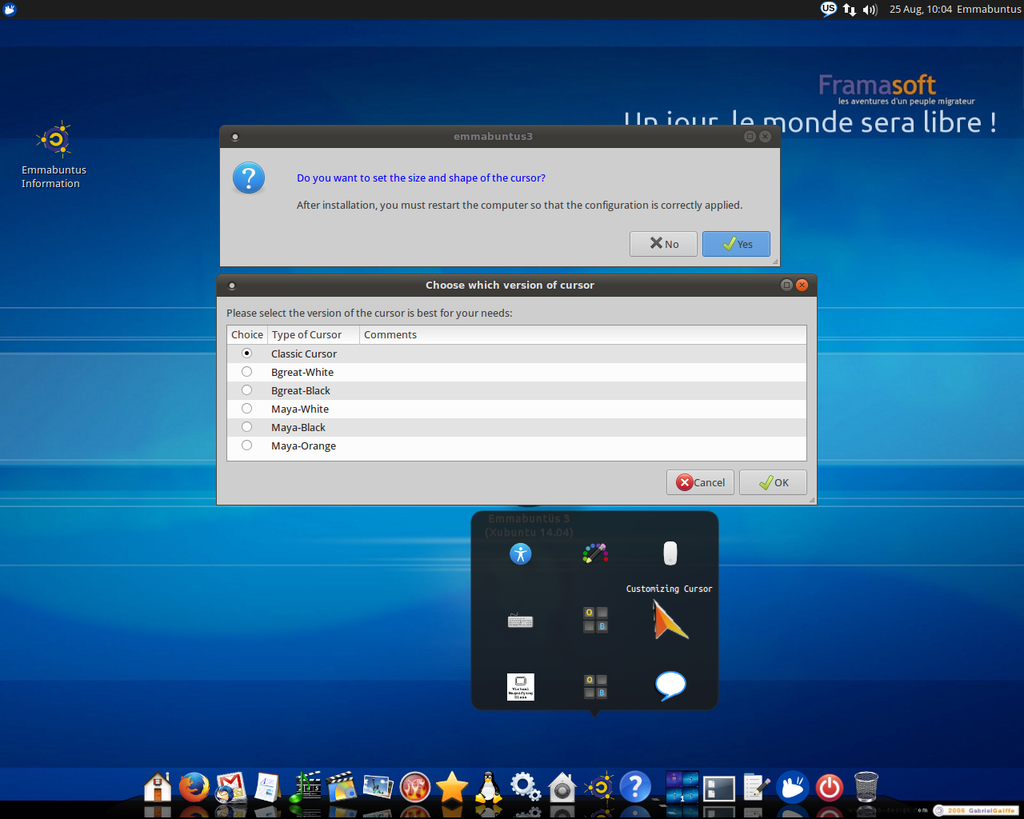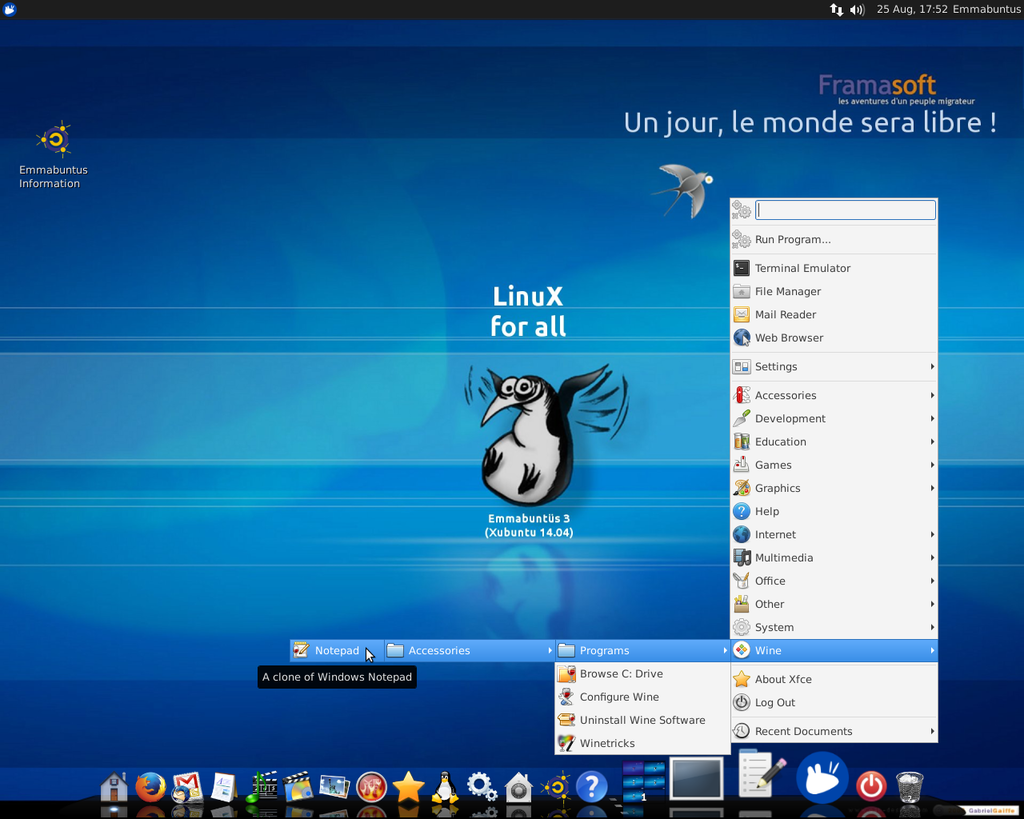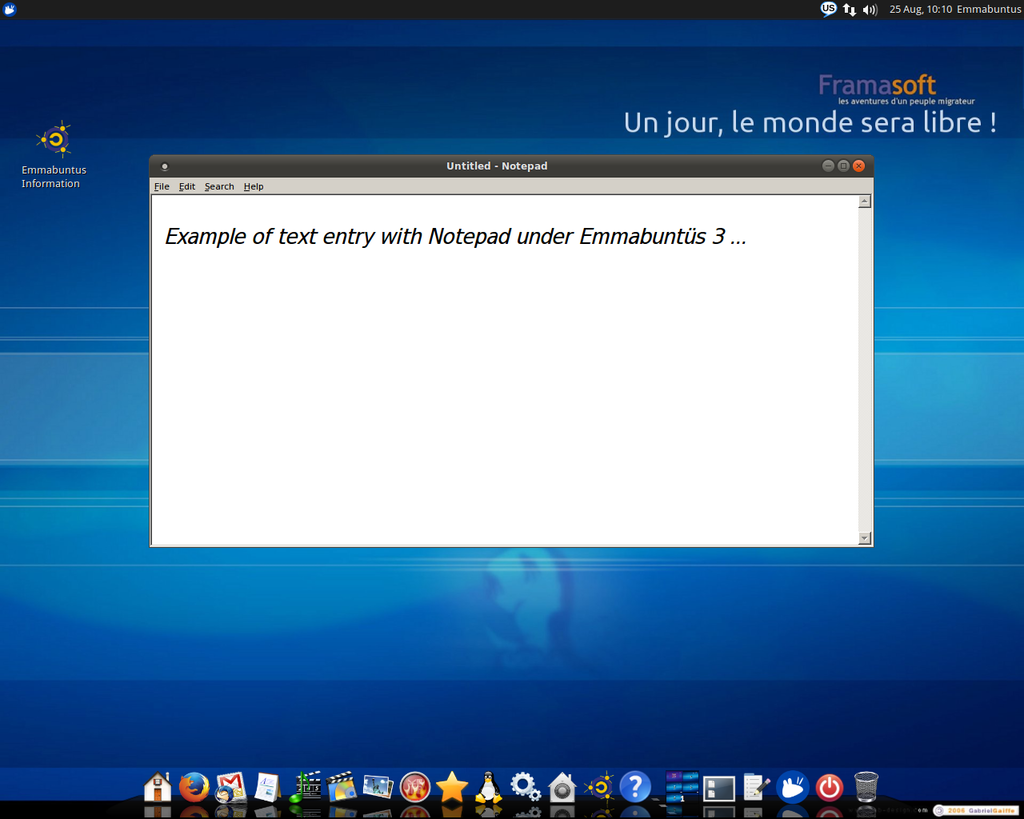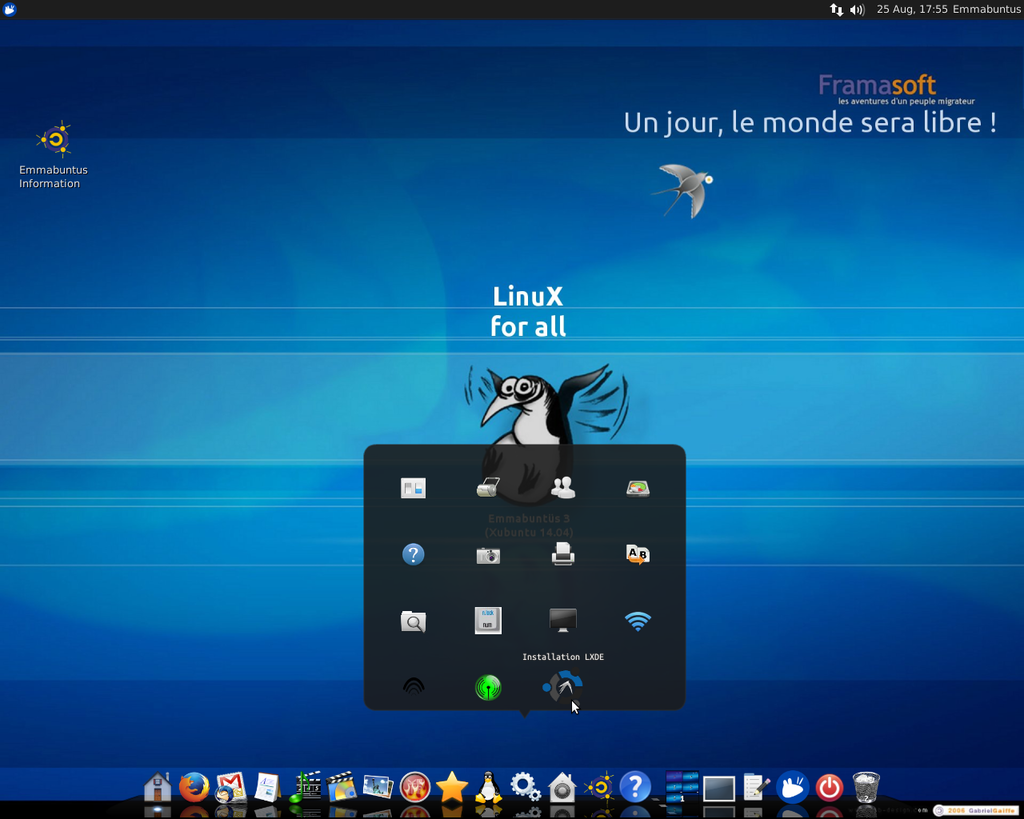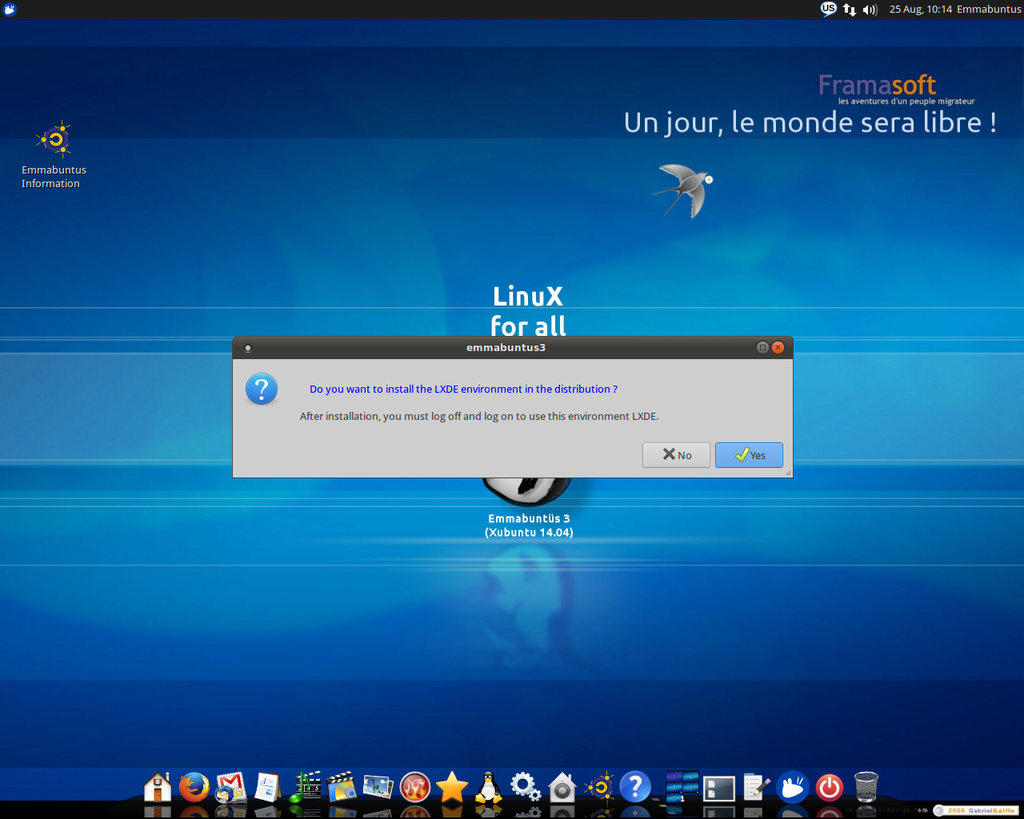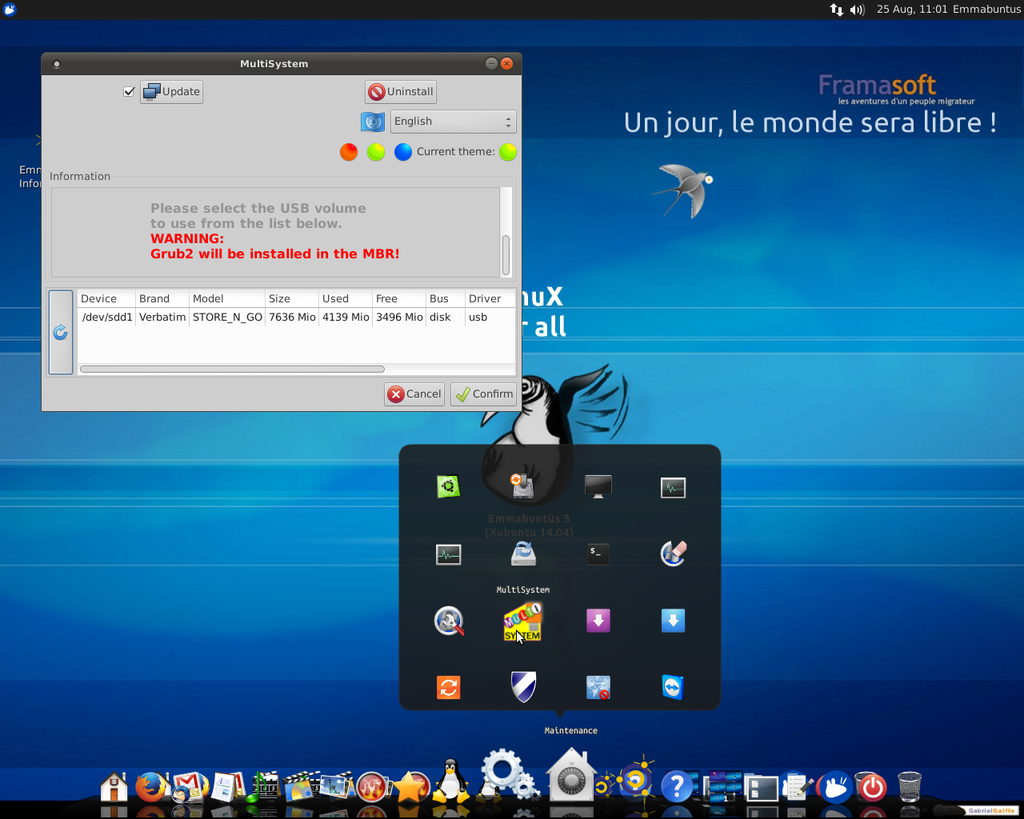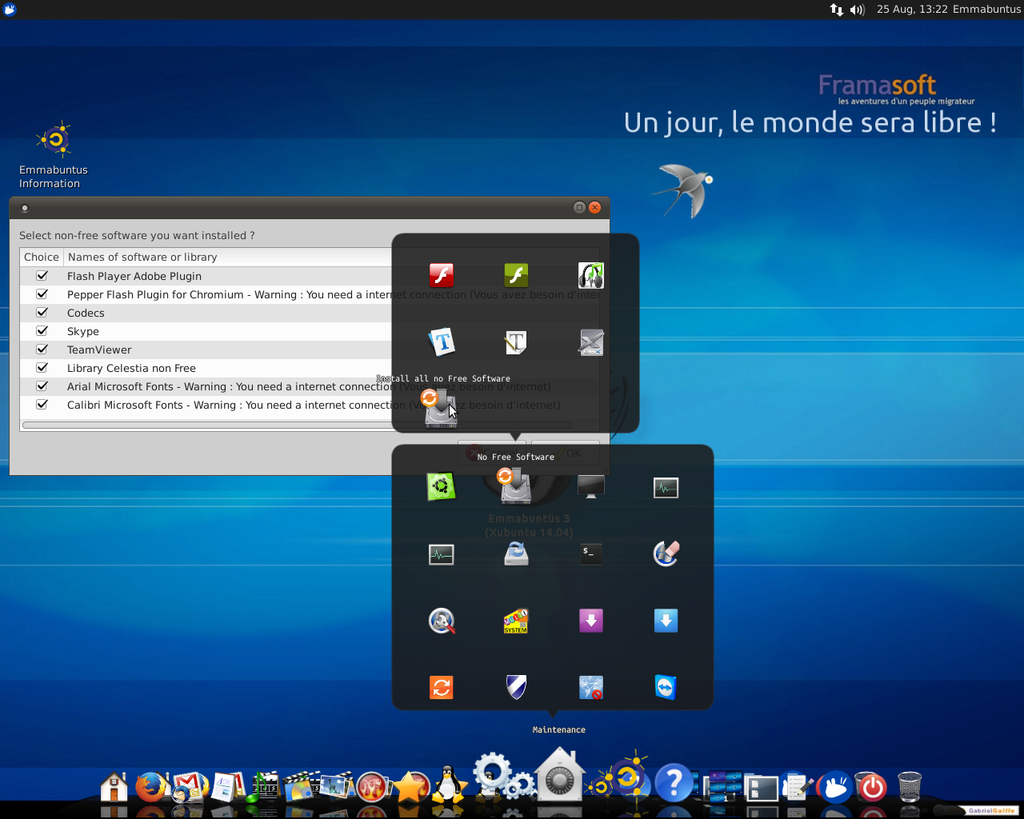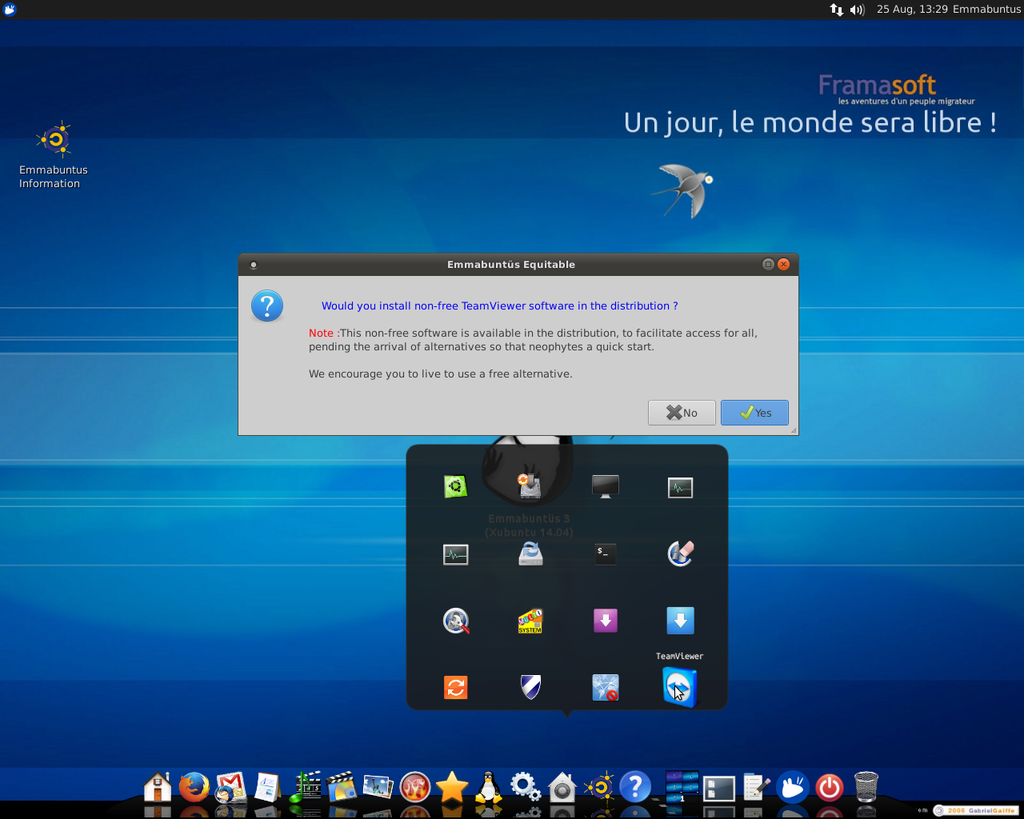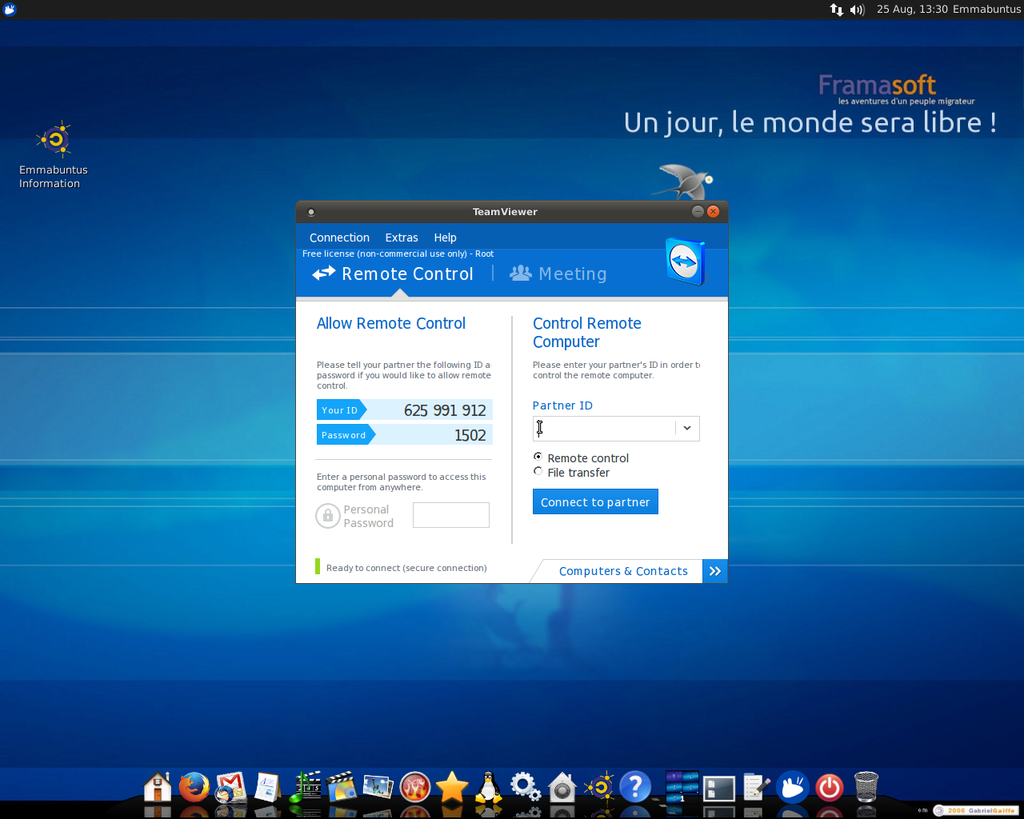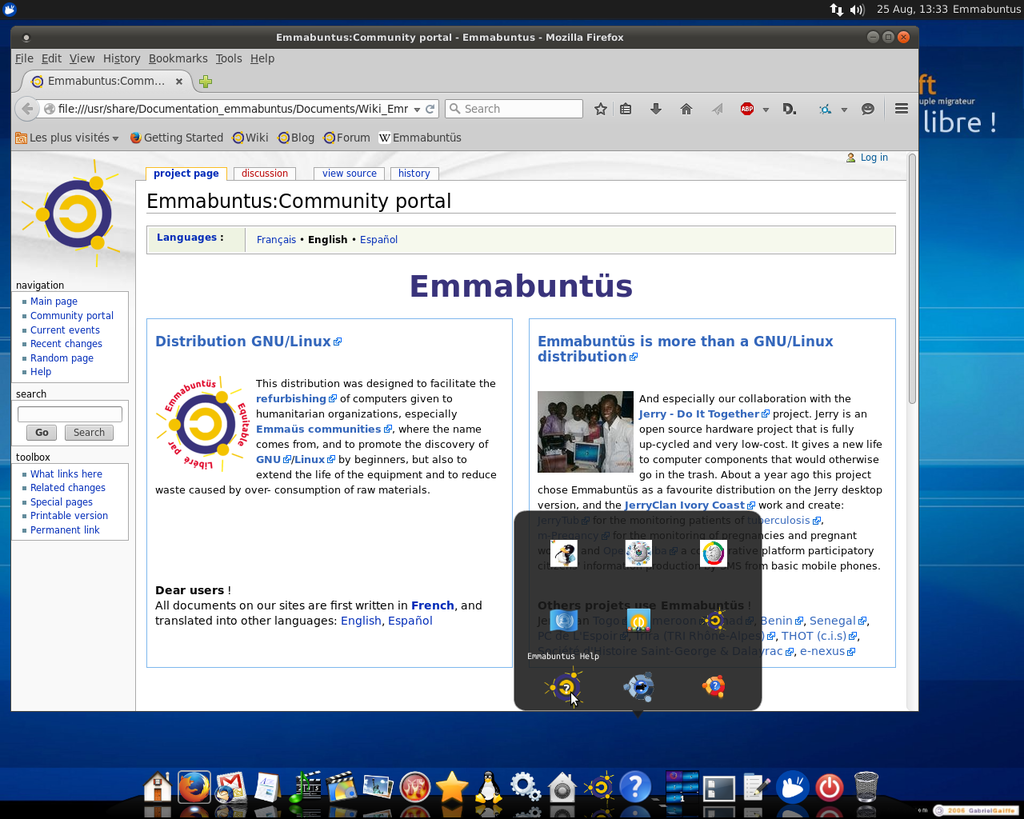I. Emmabuntüs 3 (14.04) Distribution▲
The various GNU/Linux Emmabuntüs distributions were first designed to ease the refurbishing of computers given to humanitarian associations in general, and to the Emmaüs communities in particular (hence the name of this distribution). The second goal was to help the beginners in the discovery of the GNU/Linux world, and the third one was to extend the lifetime of aging pieces of hardware in order to limit the overconsumption of raw materials (see Note 1).
The Emmabuntüs 3 (14.04) distribution is based on Xubuntu 14.04, a derivative of the Ubuntu operating system, applying the same basic concepts, but being more lightweight it can be installed on rather old computers and with less performing hardware. The most visible difference is the fast and lightweight XFCE desktop environment instead of Unity. This distribution also includes the complementary LXDE/OpenBox environment to extend its computer refurbishing capabilities.
- Main Page
- Wikipedia
- Newspaper articles
- Some blog entries (mostly in French)
- Forum
II. Project goal▲
The action of the Emmabuntüs Collective goes beyond the assembly of a Gnu/Linux distribution. What we also aim at is to put in place structures supporting humanitarian associations in their computer reconditioning tasks and encourage other persons to follow our step in order to fight against the three following scourges:
- The poverty among certain segments of the population, by providing new revenue sources to the humanitarian associations thanks to the sales of these machines.
- The “digital gap” in France and in the World, and more specifically in Africa, through the release of a distribution enriched with Free Data.
- The waste induced by the overconsumption of raw materials, by increasing the lifetime of electronic components.
III. Cooperation▲
Emmabuntüs is not only a GNU/Linux distribution, but also a collective working within some Emmaüs communities for the reuse of computers donated to them. Hence the collaboration with associations like Les Amis de la Terre, Festival de la Récup, Les PC de L'Espoir, Trira (TRI Rhône-Alpes), THOT (c.i.s), Eisenia, and e-nexus.
The collective cooperate also with associations promoting the Free Software like Montpellibre, Perpinux, Gard-Linux, Infothema, l'EPN de Durbuy (Belgium), et the History Society Saint-George & Dalayrac for the Free Culture advancement.
Since August 2012, a close cooperation exists between the two projects Jerry - Do It Together and Emmabuntüs. Jerry is an open source computer assembled inside a plastic can with salvaged electronic components. It gives a new life to computer components which otherwise will end up in the trash. This cooperation was extended when JerryClan Ivory Coast started to use the distribution for their medical aid: JerryTub for the monitoring of tuberculosis patient, m-Pregancy for monitoring the pregnant woman, Môh Ni Bah for birth declaration in remote rural territories. and OpenDjeliba a cooperative platform for sharing citizen information through the usage of basic portable phones. This project received in 2014 the first price of the Forum International francophone Jeunesse & emplois verts in Nigeria.
The project GBATA is a mobile platform for sharing real estate informations using SMS communications. In July 2015 this project was the winner of the mobile application category during the « Jeunes Talents TIC et Contenu local 2015 » contest in Ivory Coast. This collaboration gave birth to several others with the JerryClan in Ivory Coast, Togo, Chad, Benin and Senegal and the new Cameroon Emmabuntüs collective.
Since summer 2013, the Montpel'libre association helps the Montpellier Emmaüs community by proposing pre-sales presentations. The aim of this activity is to present Emmabuntüs to the potential customers who want to buy a computer and to help them making up their mind.
But the Montpel'libre support does not stop here. The customer not only takes the computer with him, but also the coordinate of the association in order to contact them in case of problems. As of today the team is composed by Pascal, Quentin, Cellou, Romain, Nicolas and Cédric who assume a permanence the second Saturday of each month.
Emmabuntüs and free software presentation by Montpel'libre, November 8th 2014 nearby Montpellier
Photo credit : Montpel'libre
In June 2015, both the collective and the association « The Emmabuntüs Friends » support the children's story project “Once upon a time was Internet” by providing portable computers for the educational activity around the Data Journey and to prepare students for the French Computer and Internet Certificate. These computers are running under Emmabuntüs, enriched by data coming from the Free Culture, and including Wikipedia et Vikidia (Encyclopedia for children), and books fallen into the public domain. In addition everything is accessible off-line in order for Élodie & Maryse to be fully autonomous when they present the free program ideas and concepts to students within schools not plugged yet into the Web.

Once upon a time was a wonderful world whose roads were made of light ... Its name was Internet.
Photo credit : Élodie Darquié & Maryse Urruty (CC-BY-NC-ND)
IV. Requirements▲
For a comfortable usage of Emmabuntüs 3 (14.04), the reconditioning workshops install it on computers featuring Intel Pentium D @3.00 GHz or Dual Core processors, with at least 1 GB of RAM and 80 GB on hard disk.
For less powerful computers like portables with Pentium M, or desktop computers with Pentium 4, 4 HT with 512/768 MB of RAM and 40 GB of hard disk, it is strongly suggested to install Emmabuntüs 2 or HandyLinux compatibles with non-PAE processors.
The machine originally running under Windows 95, 98, 2000 or NT do not have the performance required to run the software currently available, and it is better to use the SliTaz distribution.
Emmabuntüs 2 and 3 can also run on LXDE with a RAM footprint of respectively 90 and 117 MB at startup time. See the installation of LXDE under Emmabuntüs 3.
V. Features▲
This list summarizes the Emmabuntüs key features.
- Distributions based on Ubuntu LTS (10.04, 12.04, 14.04) variants.
- Fast installation mode through automated scripts.
- Live mode on DVD and USB key (Multisystem, UNetbootin, USB-Creator).
- Autonomous install without Internet connection, everything is included in the distribution.
- Choice given to the end user to install - or not - the non free software packages (Flash Player, Codecs, Skype, etc.).
- More than 60 additional applications.
- Configurations of Internet browsers and LibreOffice suite.
- A dock giving an easy access to the complete set of applications.
- Seven supported languages (English, French, Spanish, Portuguese, Italian, German, Arab)
VI. Emmabuntüs Overview▲
The goal of this presentation is not to describe the whole set of software inclusive within the Emmabuntüs distribution, but rather to present an overview of this specific GNU/Linux distribution and to show that it can be used in the frame of “Digital Public Spaces” as well as nursery and elementary schools.
VI-A. Installation▲
Emmabuntüs is installed like any other Ubuntu/Xubuntu distributions, except the facts that you need at least 15 GB of free hard disk space, and that you do not need an Internet access to complete its installation. We even strongly suggest not to connect the computer with Internet during this process in order to ensure a seamless installation. You can then establish the Internet connection during the first reboot of the machine to finalize your installation by downloading - or not - some non-free software packages.
To obtain more information on the various installation methods, you can look at the Installation Page of the Emmabuntüs site or this excellent install tutorial on Developpez.com, as well as information about data configuration on the Free Culture site.
We also suggest that you read this FAQ page to avoid some known installation pitfalls.
VI-A-1. Launching the installation from a DVD▲
When you start the installation from a DVD, you can press the space bar as soon as the Vitruvian Man symbol is displayed,

and then you will be given the opportunity to chose your preferred language during the Live mode startup or for the full installation.
You can also use 2 additional menus allowing you to limit even more the number of required configuration screens during the install process :
VI-A-2. First reboot after install▲
Startup screen :
Selection of the Xfce Classic menu (suitable for old computers) or Whisker (more modern indeed, but also eating more RAM)
Then the selection of the dock level :
And finally the Emmabuntüs 3 welcome:
Information screen concerning the non-free software packages installation :
Selection screen for the non-free software packages : you check - or not - the package you want to install like the proprietary Codecs, board drivers etc … In order to install the Microsoft fonts and the Pepper Flash player you need an active Internet connection.
Information screen concerning the deletion of the languages included in the distribution, to avoid downloading updates for unused languages :
Selection screen to delete unused languages (only English is kept here) :
Deletion of the selected languages :
Then the system checks the availability of the language support :
and finds out that it is not fully installed. We install them now :
Language support changes being applied :
VI-B. The Dock▲
The Dock or application launcher is Emmabuntüs key stone, and provides independence from the other Ubuntu distributions it is derived from. This is the Cairo-Dock which is used since the very first release of Emmabuntüs, based on Ubuntu 10.04.
Its usage evolved between the first version Emmabuntüs 10.4 and the version 14.4 : it is now multilingual, accepts 3 levels of complexity and is auto hiding or not, depending on the screen format.
Selection of the desired dock level :
Example of the 3 levels of the Dock for the Office category :
VI-C. Communication▲
This category includes Internet browsers, email clients, instant messaging clients, tools for Internet data sharing tools and cooperative working.
In this category, emphasis was put on the Firefox and Chromium Internet browsers to ease the parental control and the fight against advertising and Phishing (or Fishing)
Blocking example for a site rated XXX ;)
Blocking example for an unrated site :(
To remove the blocking action on unrated sites, you need to ask for a reevaluation of this site by simply entering its rating category and your email address :
You can find more information about the parental control on this page.
VI-D. Office suite▲
The Office category has been particularly designed to offer the right tools for each of the 3 user's levels : LibreOffice for the experts, AbiWord/Gnumeric for the beginners and OOo4Kids for the children.
Writer, the LibreOffice suite word processor, has been enhanced by the grammatical corrector extension Ltools.
This category was also enriched with software allowing to share culture and knowledge without the need for an INTERNET connection. Thanks to Kiwix a reader which let you take Wikipedia with you, even in the middle of the desert ;)
First you need to load the data on your machine, for example a subset of Wikipedia (for more information see Installing Culture Free Data on Emmabuntüs.
Calibre let you read your preferred bedside books when once they fall in the public domain. In order to demonstrate how easy it is to use this reader, Emmabuntüs, by default, embeds the book “20,000 Leagues Under the Sea” in three different languages. Another book (French only for the time being) explains what is the Open Street Map collaborative mapping.
VI-E. Audio▲
Few pieces of music are also embedded together with the with the Clementine et Rhythmbox, in order to test immediately the audio devices included in the computer.
VI-F. Video▲
In the video category, two classic media players are present : Kaffeine(KDE)
and VLC (VideoLAN)
This category also includes the KdenLive video editor, as well as the WinFF et Arista Transcoder format converters. Finally the Cheese application let you test web-cams easily.
VI-G. Photo▲
This category contains the classic Shotwell and gThumb image viewers/organizers, as well as GIMP and Inkscape graphic editors. In addition the DigiKam image organizer and tag editor, allows the importation of pictures from various media, and their arrangement within albums.
VI-H. Burning▲
A set of software to let the final user pick the one best suited for him/her, and also handle correctly the CD/DVD reader/writer device.
Here after an example using the Brasero software :
VI-I. Entertainment▲
The entertainment category contains a set of games for adults (GRAMPS, Stellarium, Celestia, SweetHome3D), but also little games for children (SuperTux, SuperTuxKart, TuxGuitar).
Warmux is described in Wikipedia as a free « turn-based artillery game ». As a humorous video game it gives you the opportunity to have a good time, by playing alone or with several partners. As a free software, it can be modified according to the player taste by using other free software.
To start with, it is very easy to modify the background map by creating a new image under GIMP, and adding it to the existing list. Then it is possible to insert your own avatar within one of the existing team. Likewise, weapons can be transformed to, for example, shoot missiles with a banana … Finally, sounds are also customizable with Audacity, with which the player can record voice and sounds effects.
This category also contains the application PlayOnLinux, which allows some Windows-based programs to run on top of GNU/Linux systems, in particular in the video game area, but you must have on hand the original CD or DVD of the games.
VI-J. Education▲
This category includes a set of educational software (TuxPaint, TuxMath, Gcompris, etc) geared towards young children between 5 and 12 years old. In addition the office suite OOo4Kids allows 3 levels of learning experience (beginners, average, expert), giving the possibility to monitor the evolution of your child.
Since Emmabuntüs 3 OOo4Kids speaks 6 different languages, thanks to the PicoSvoxOOo extension. It also includes extensions to automatically highlight syllables or phonemes. A new icon bar has been added to give an quick and easy access to these new functionalities.
An example of sentence reading with the speech synthesis PicoSvoxOOo [French] :
Another example showing the syllables break down :
or the colored phonemes :
VI-K. Accessibility▲
Emmabuntüs 3 features this new category which includes a screen glass magnifier :
the text to speech synthesizer gSpeech which reads any text selected in a window :
and finally the capability to modify the size and shape of the cursor :
VI-L. Utilities▲
In order to provide a better compatibility with programs running only on Windows platforms, WINE is a built-in part of Emmabuntüs. For example it allows you to run the outstanding Notepad++ text editor.
Opening Notepad++ with WINE :
Example of text editing :
Within this category and in Expert mode, it is also possible to install LXDE/OpenBox.
One advantage of the LXDE/OpenBox environment is that it consumes less memory resources. For more informations you can look at this tutorial : Emmabuntüs installation
Example of LXDE desktop with application AbiWord open.
VI-M. Maintenance▲
This category contains a set of software used for the system maintenance, like Ubuntu-Tweak (easy system configuration and updates cache cleaner), Htop (system monitor process viewer) and SysInfo (hardware and software informations).
In addition, by creating LiveUSB multiboot media, Multisystemallows you to easily deploy Linux distributions on USB keys.
For more information, you can read this tutorial explaining how to easily create an autonomous multiboot Live USB with Multisystem.
This category gives also access to a set of installation scripts for some non-free software, like the controversial Skype, Flash Player, and codecs. In that matter, we prefer not stay on an pure ideological position, and integrate them in the system, rather than taking the risk to disappoint people accustomed to proprietary software. They will not understand that the Free Software world is more restrictive than the private/proprietary world.
These non-free software are included in the ISO media, and can be installed by the end user either during the first reboot after the system installation (post-install process), or later by using its proper icon in the dock.
TeamViewer is a proprietary software, free of charge for non-commercial usage. It allows remote control between two machines in order to help and train new users.
VII. Help▲
Emmabuntüs includes an off-line help directly from the Dock, or by clicking one the desktop Emmabuntüs icon. The complete set of documents explaining the Emmaüs and the Free Software movements is under the ~/desktop/Information folder.
VIII. Conclusion▲
This distribution and its applications which could sometimes look redundant, has been designed to allow the usage of GNU/Linux to all the members of one family. Some independent bloggers, writing about Emmabuntüs 3, translate this into “The return of the GNU/Linux anti-waste distribution” [French], « Xubuntu spin with an attractive desktop and plenty of apps! », and for Emmabuntüs 2 « The All-In-One Fair Distribution » [French], « Uma distro Linux para iniciantes », « All-Inclusive French Resort », « Multifunktional Kompakter Allrounder für ältere Computer».
IX. Acknowledgements▲
Thanks to you for having read this presentation. Please remember that the whole Emmabuntüs community is available for you on the site www.emmabuntus.org. In order to continue your Emmabuntüs journey see Emmabuntüs 3 Installation ;)
Thanks to zoom61 for the improvements he made in this presentation, and his help during the publication.
Thanks to xxx for the spelling and grammar checking.
According to theADEMEagency, each step of the hardware equipment during its lifetime, from fabrication to disposal and during its utilization, can be quantified in terms of environmental impact : manufacturing a computer and its screen require 1.8 tons of resources (240 kg of fossil energy, 22 kg of chemical products, 1,500 liter of water).
For the Ecoinfo group, action is the priority. Each member of the group acts at its own level (purchasing, maintenance, network development) but each of us can also contribute by his/her behavior. Their conclusion : “if it is already possible to intervene at every stages of the computer hardware cycle, the most efficient action you can make to limit the environmental impact of these materials, is to reduce the amount of purchases and increase their lifetime !”





